SEOUL — Good morning from Incheon International Airport (ICN), the gateway to Seoul and beyond. After a fantastic few days with the Korean Air (KE) team, it’s time to head back to London.
Today, we’re experiencing Korean Air’s Business product, Prestige Class, aboard the Queen of the Skies, the Boeing 747-8.
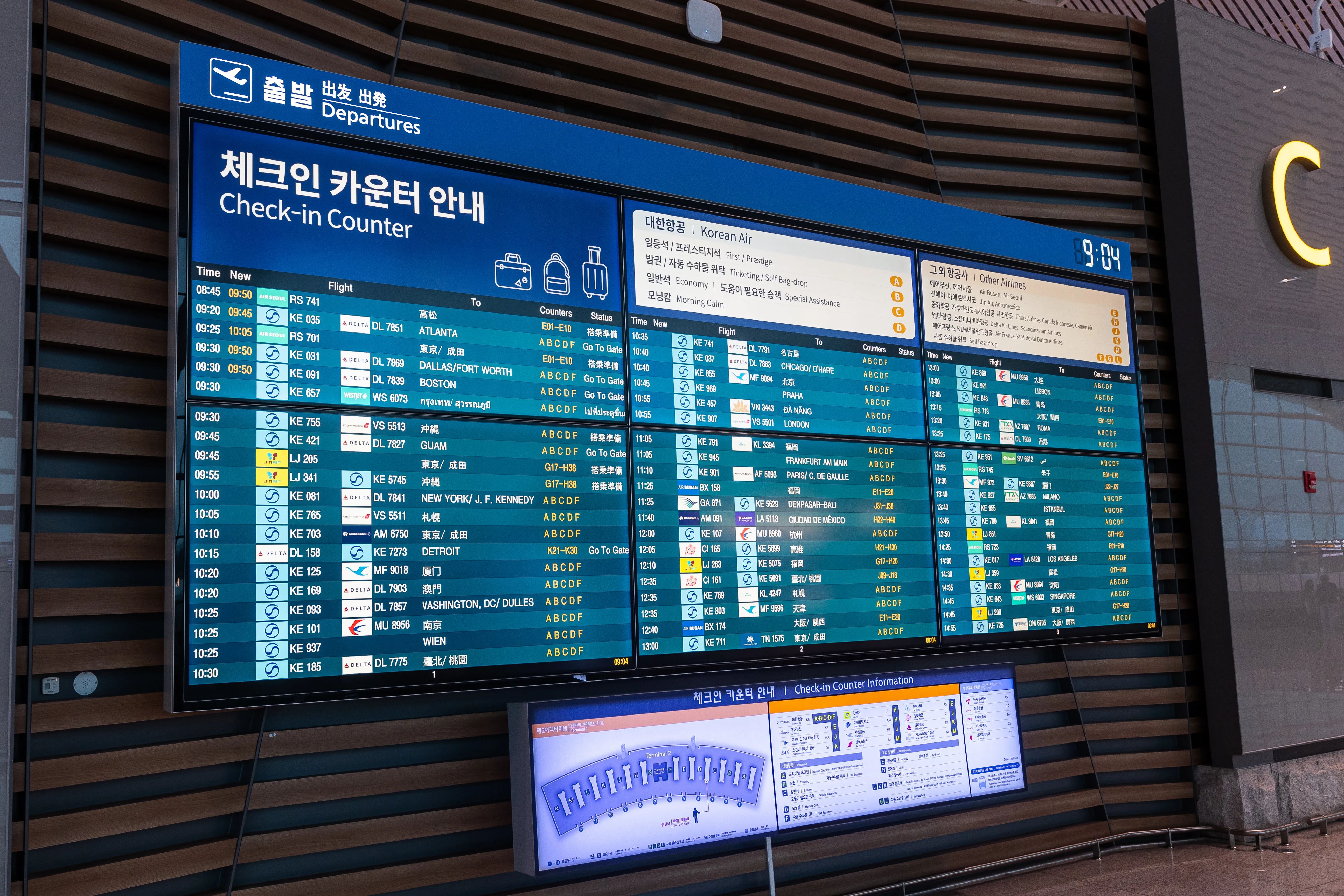
Check-in
We begin our journey at Incheon’s Terminal 2, the airport’s newest terminal and the hub of KE. I arrived via shuttle bus from our nearby hotel and headed promptly to the departures area.
Passengers travelling in First and Prestige class, and KE’s Million Miler Club and Morning Calm Premium members, benefit from priority check-in. I found my way to the exclusive, spacious check-in area in Zone A, separated from the rest of the terminal.
Having swiftly received a boarding pass and lounge invitation, I proceeded straight to security. The terminal doesn’t offer fast-track security for its premium customers; however, I appreciated the modern, visually stunning departure hall before going airside.
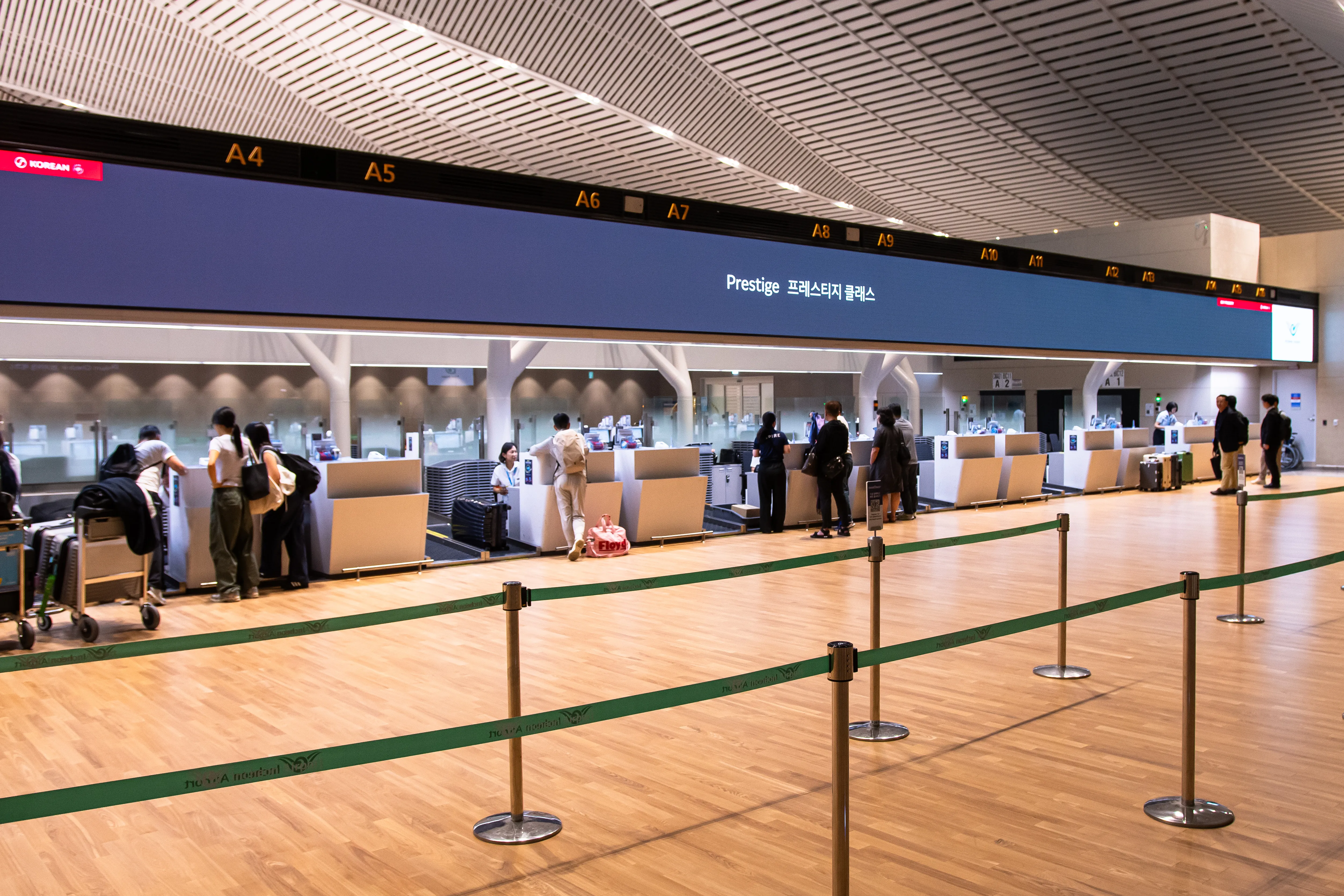
ICN’s Airport Expansion
The end of 2024 marked the completion of ICN’s primary Phase 4 construction project, doubling the size of Terminal 2. The airport is expected to welcome over 100 million passengers annually, handle 1,000 flights daily, and increase its cargo capacity.
Incorporated throughout the terminal are advanced technology, cultural and artistic elements, and ultra-HD digital screens, all of which improve the passenger experience. Two outdoor gardens can also be found on the eastern and western sides, offering modern beauty to travellers.
Travelling through the newly expanded T2, visitors can expect a wide range of shopping outlets, including duty-free and designer stores, as well as multiple food and drink outlets. Visitors can also enjoy various activities when airside, with traditional exhibitions, performances, and an observatory deck.

Airport Lounges
This summer, Korean Air recently unveiled its newly renovated lounges at Incheon, including the Miler Club and Prestige East lounges. Both offer an enhanced experience, featuring live stations where gourmet cuisine is prepared, an international buffet, and wellness facilities.
Two Prestige Garden lounges situated at the far ends of the terminal have also opened, adding extra capacity. It provides passengers with a relaxing atmosphere and overlooks an outdoor garden.
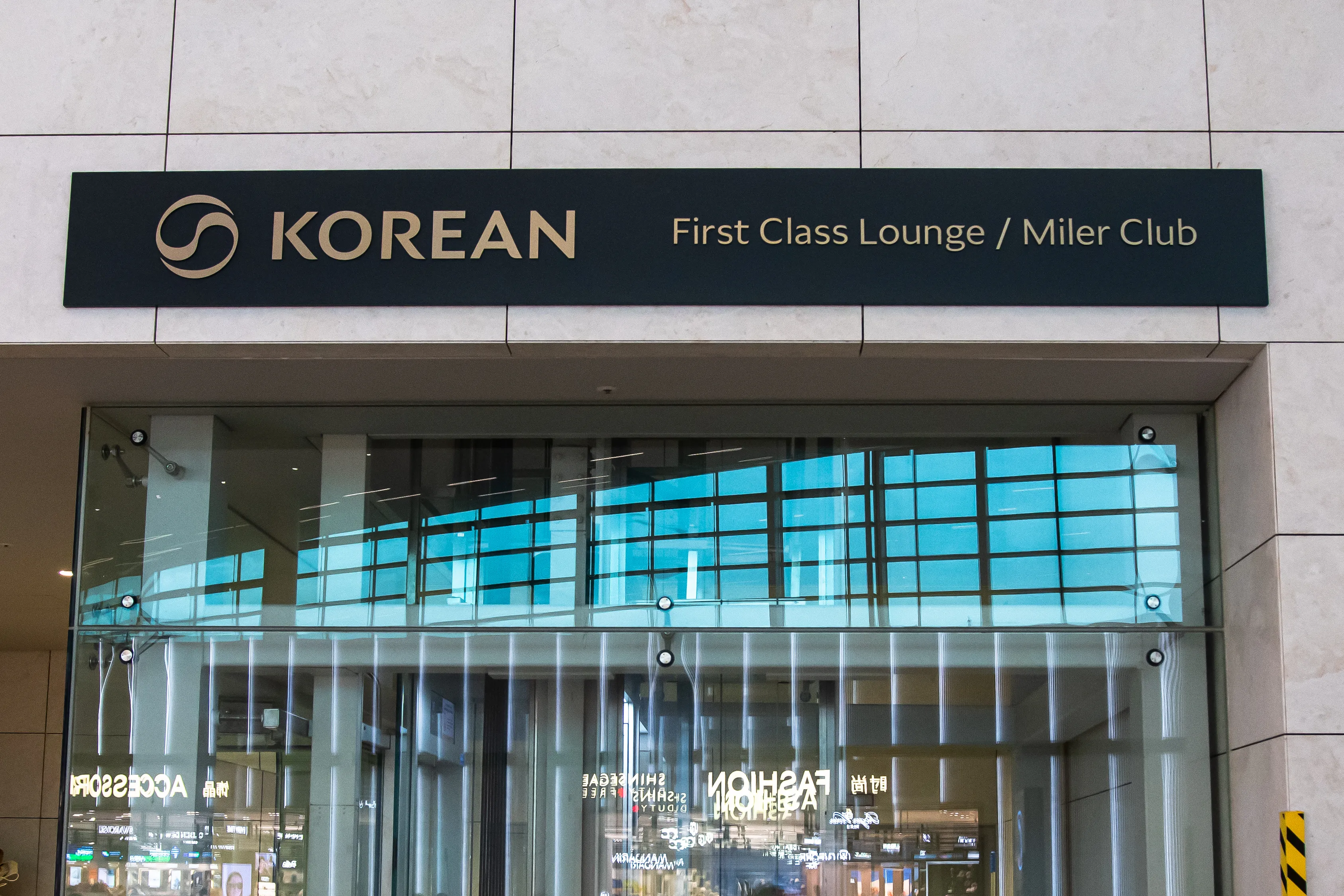
In all lounges, customers can expect modern, luxurious interiors with contemporary design. A colour palette of gold, charcoal, and ivory gives a premium feel throughout.
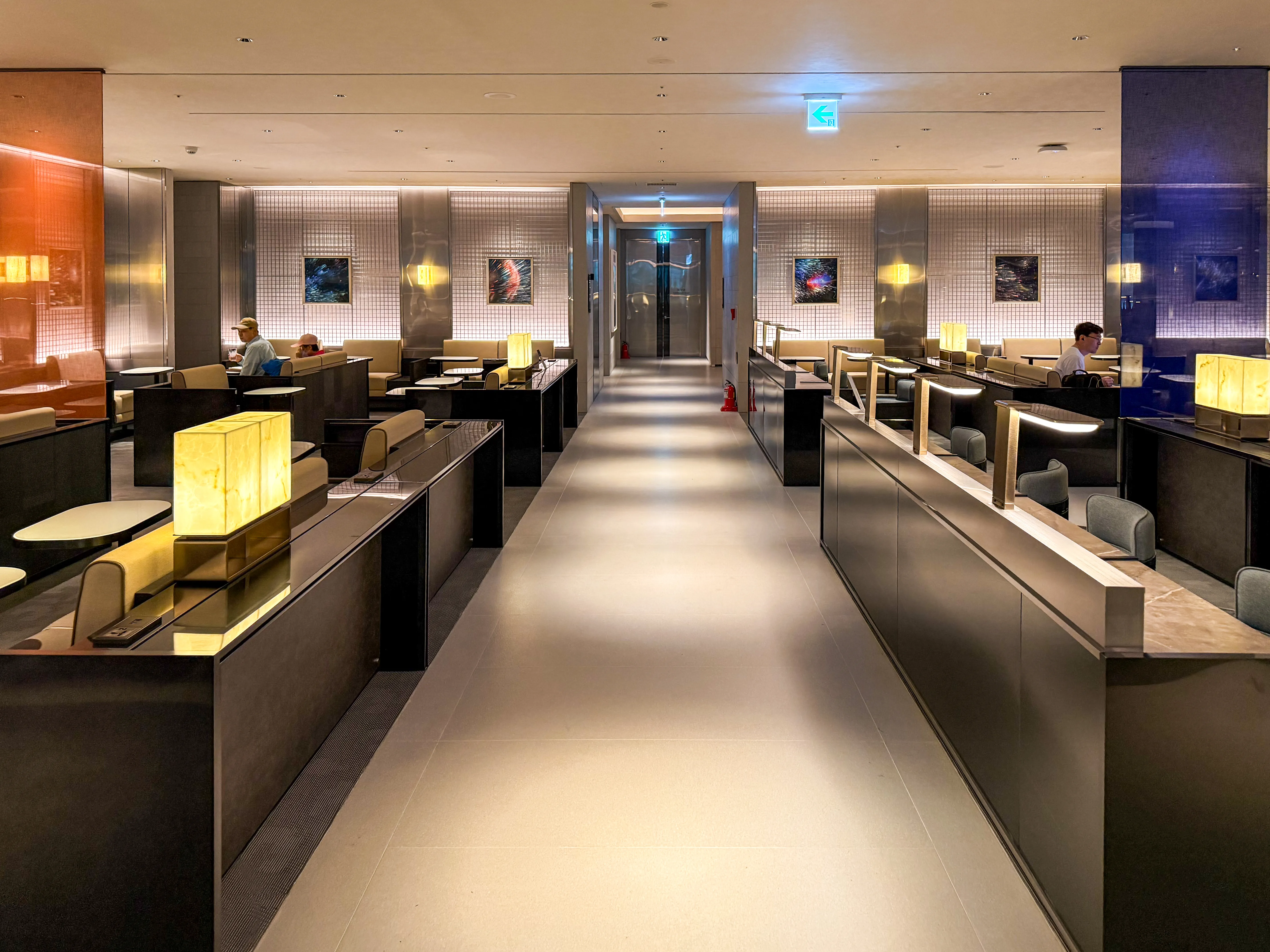

Renovations are still ongoing for KE’s First Class and Prestige West and East lounges, due to be completed in 2026. Its total capacity is expected to be 12,270 square meters, accommodating over 1500 passengers. The airline’s lounge renewal project ensures a premium, efficient service for customers ahead of its full integration with Asiana Airlines (OZ).
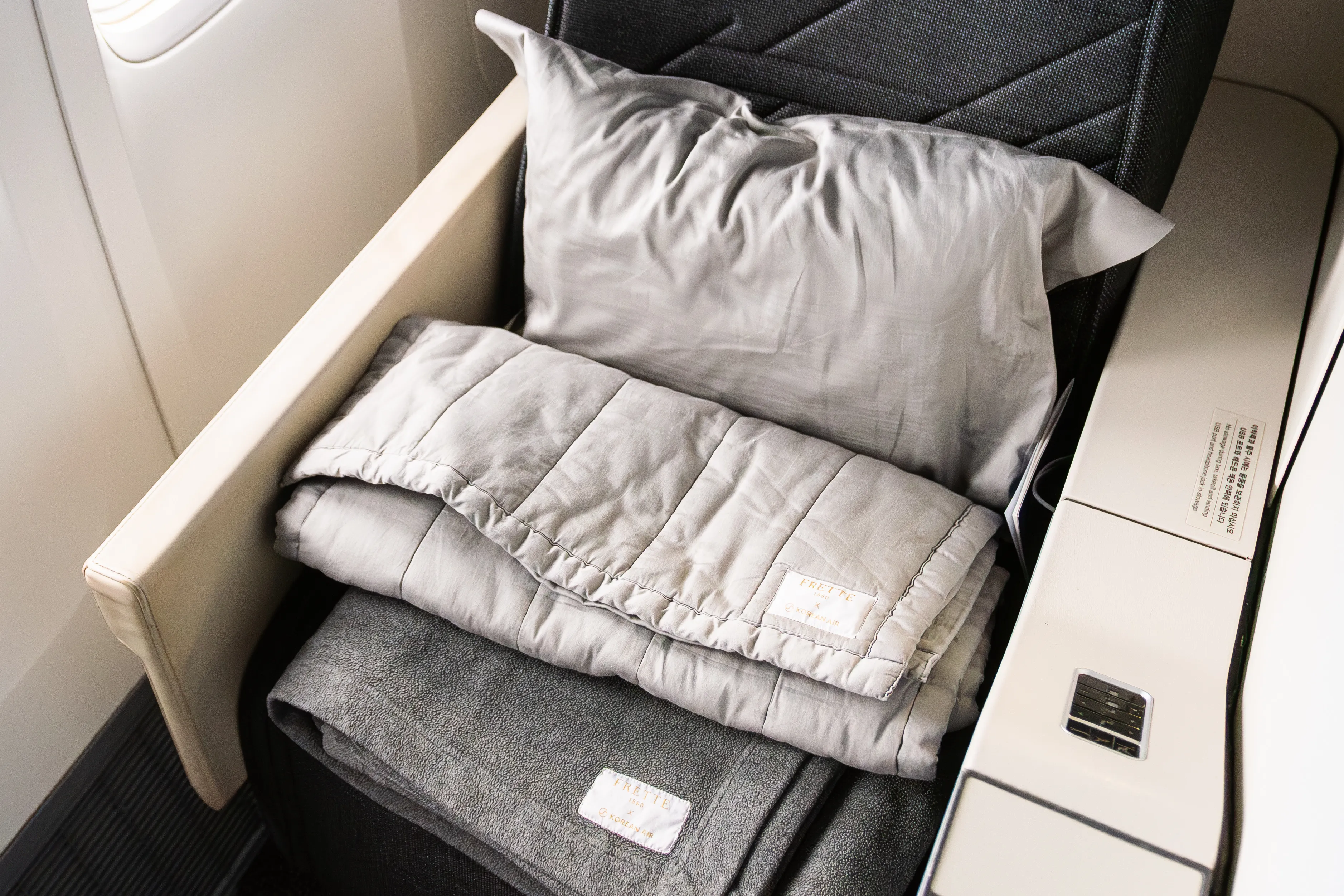
KE’s Brand-new Cabin Products
As part of its major rebrand, Korean Air has enhanced its First, Prestige, and Economy Class products. In addition, the airline has recently introduced a new Premium Economy cabin, set to be installed on 11 Boeing 777-300ER aircraft. The retrofitted fleet will operate with a three-class configuration, removing its First Class cabin.
The upgraded First Class product, Kosmo Suites 2.0, features louvred sliding doors and raised suite partitions to improve privacy. Sophisticated seat controls and a larger dining table ensure added convenience.
KE’s next-generation Business class product, Prestige Suites 2.0, includes new features such as wireless charging and Bluetooth connectivity. 132cm-high seatbacks and sliding partitions also enhance privacy.
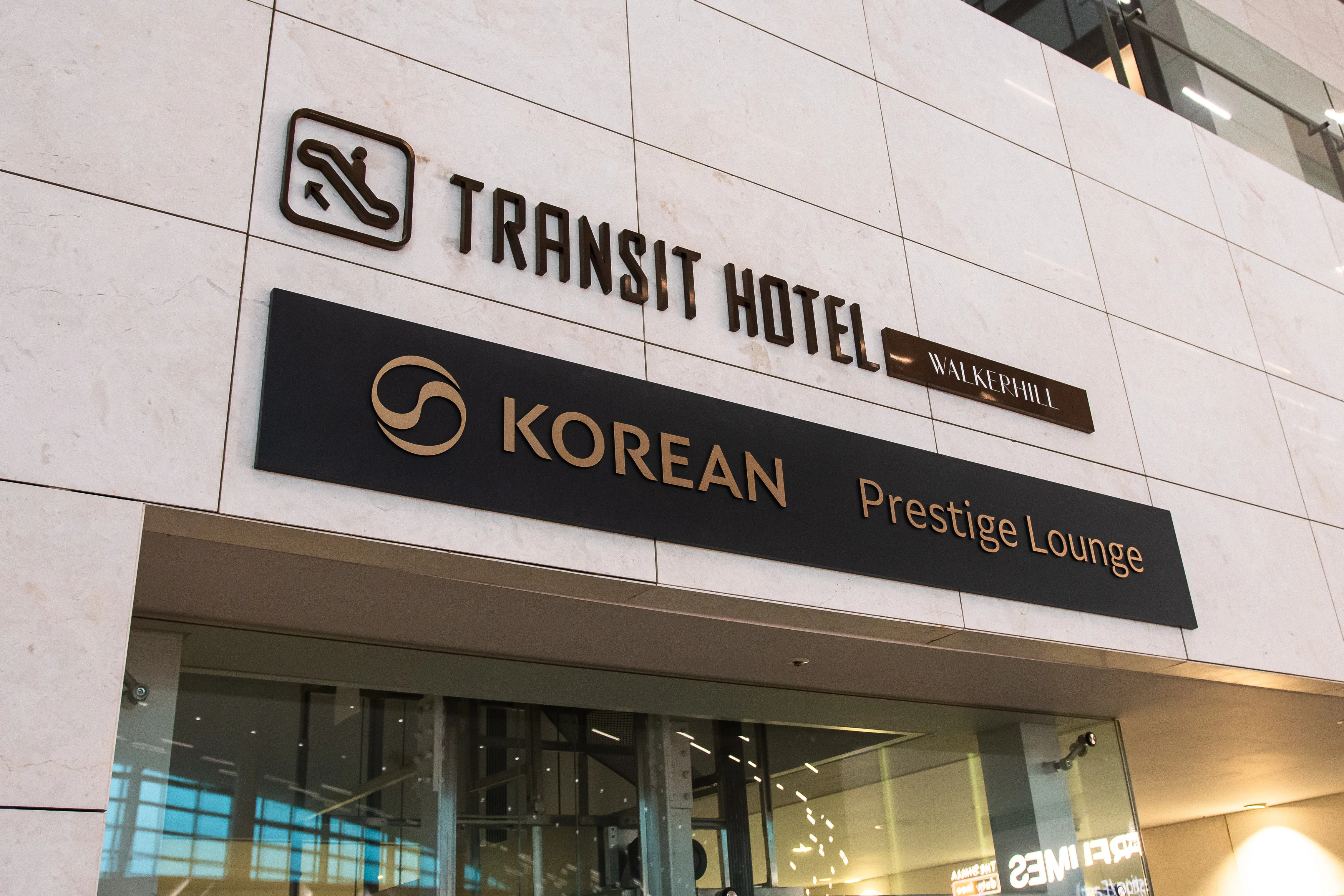
Korean Air’s premium customers can expect new bedding, tableware, and amenity kits from high-end international brands. First and Prestige Class features quilted mattresses, a cotton blanket, and a Frette pillow. First Class customers also receive loungewear for comfort.
The airline has partnered with world-class brands such as Armani/Casa (Prestige Class) and Bernardaud, Christofle, and Riedel (First Class) for its tableware. Full-size Chinaware and glassware have been introduced to elevate the dining experience across the cabins.
Exclusive amenity kits by British luxury brand Graff feature eco-friendly materials and rotating designs. Skin care products, dental kits, and an eye mask are inside.
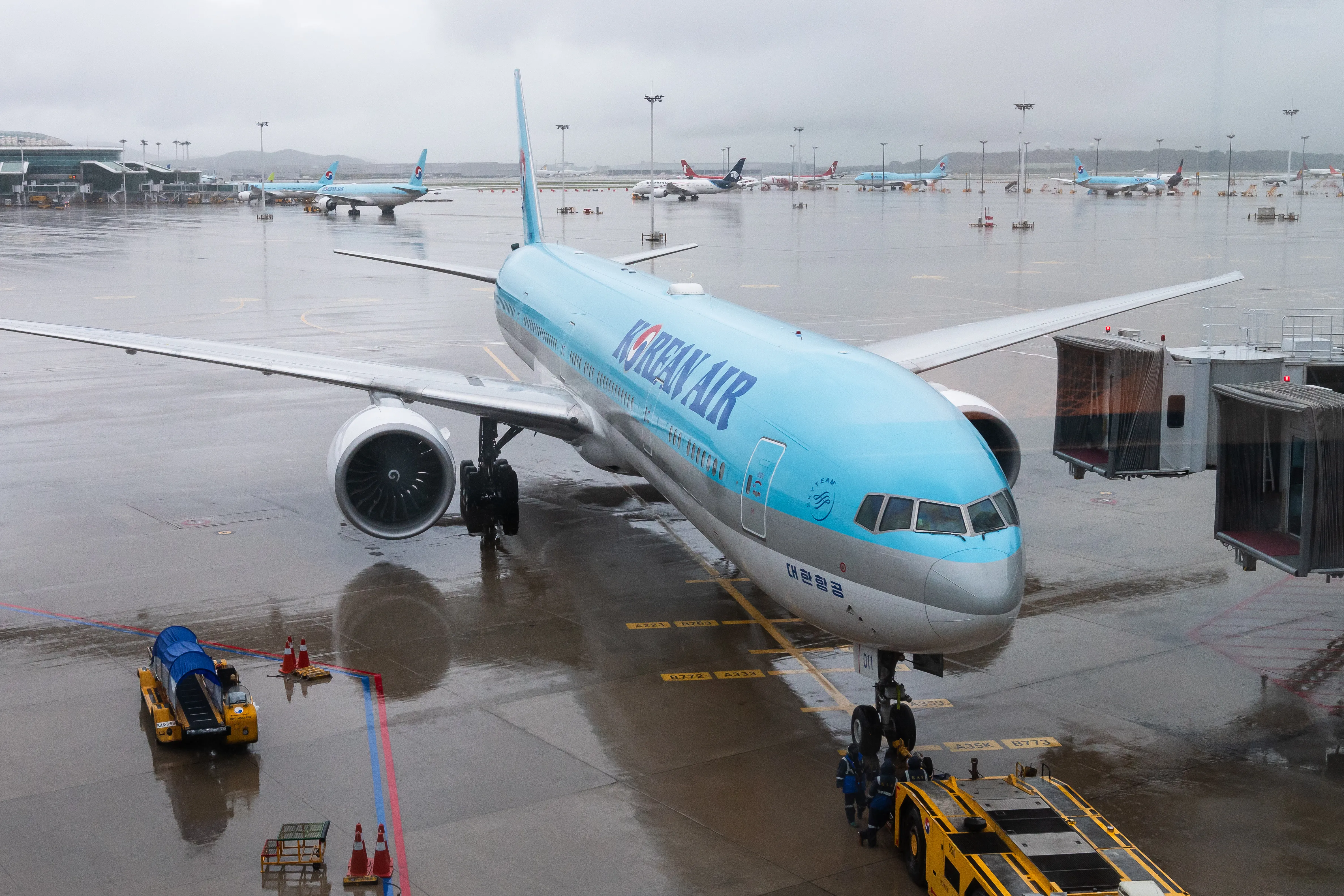
Airside Experience
I headed to the Prestige East lounge, which, unsurprisingly, was pretty busy due to the number of long-haul flights departing later that morning. Nevertheless, I managed to find a table and had breakfast in the lounge.
Options included a variety of hot and cold dishes, a bakery, a bibimbap area, and a beverage section. The lounge also features shower facilities and massage chairs, both of which I unfortunately did not have time to try.
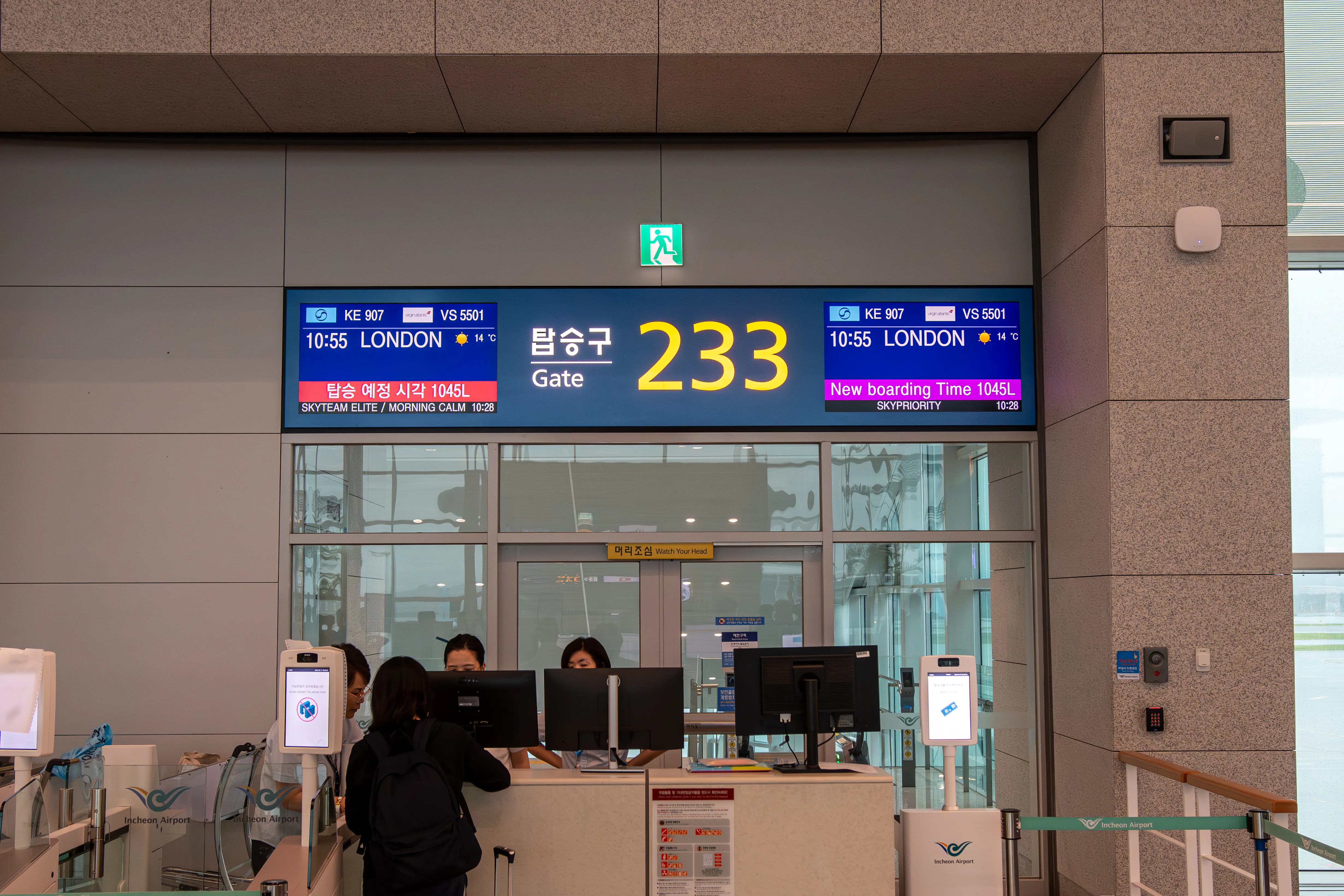
I slowly made my way to the gate about an hour before departure, taking in the various Korean Air movements out on the ramp. Through KE’s global hub at ICN, millions of passengers are served annually with a modern fleet of 138 aircraft.
An expansive cargo network also supports the airline; KE is ranked among the world’s top five cargo companies, with 23 dedicated freighters transporting essential items worldwide.
A majestic sight then came into view, our aircraft for the long journey ahead. Korean Air is one of the very few remaining commercial airlines to operate the Boeing 747, along with Lufthansa (LH) and Air China (CA). KE currently has five B747-8i passenger aircraft in service, alongside seven B747-8F and four B747-4F freighters.
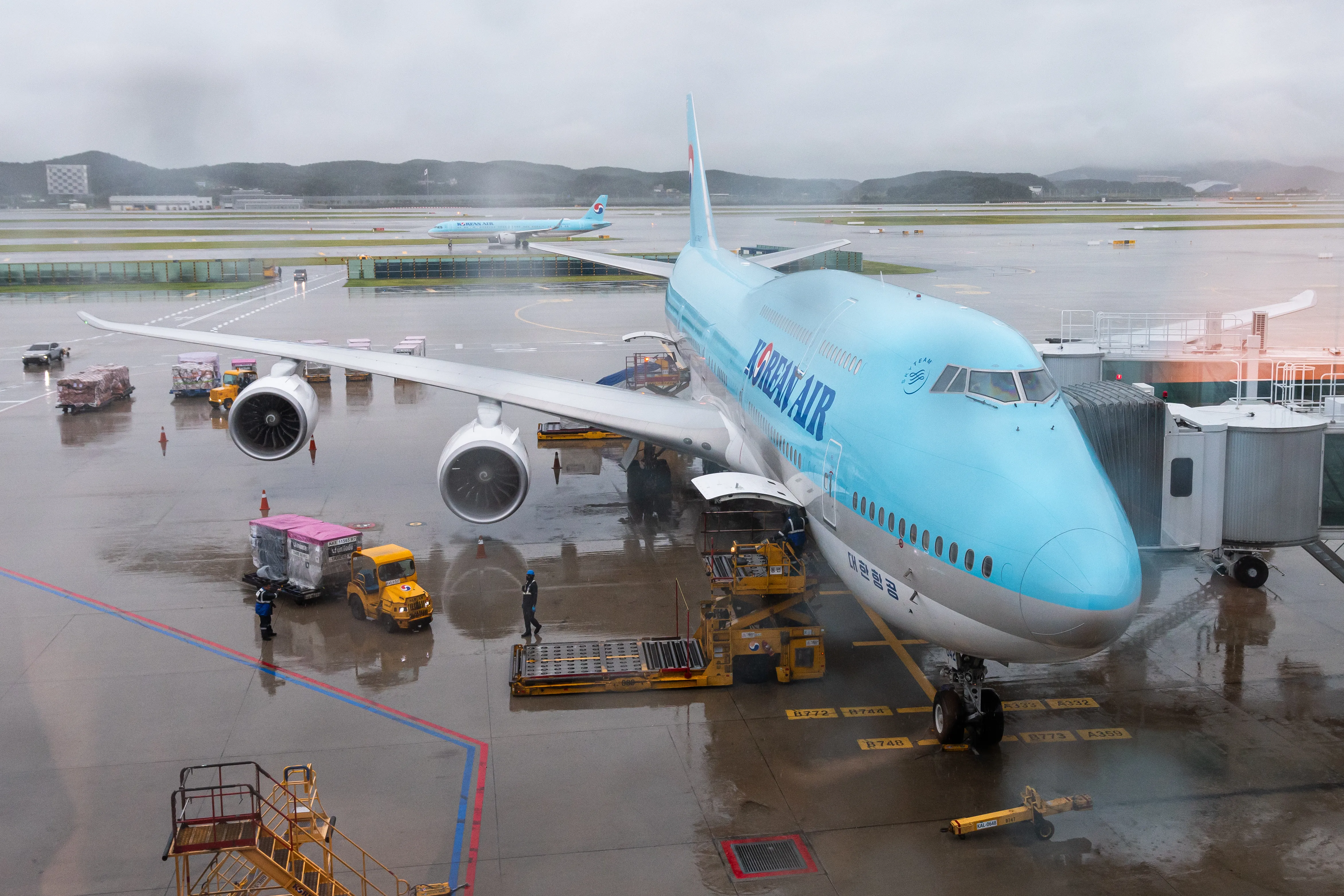
Korean Air’s Queen of the Skies
Welcome aboard KE 907 to London Heathrow, operated by an 8-year-old Boeing 747-8, registered HL7642. I have the pleasure of experiencing Korean Air’s Prestige Suite, seated in 10J on the lower deck, for the long 14-hour flight home.
At my seat, I found a mattress, a blanket, a Frette pillow, and an amenity kit by Graff. Slippers, noise-cancelling headphones, a bottle of water, and a menu were also included. In the literature pocket, KE’s Morning Calm magazine, Duty Free booklet, and a safety card were provided.
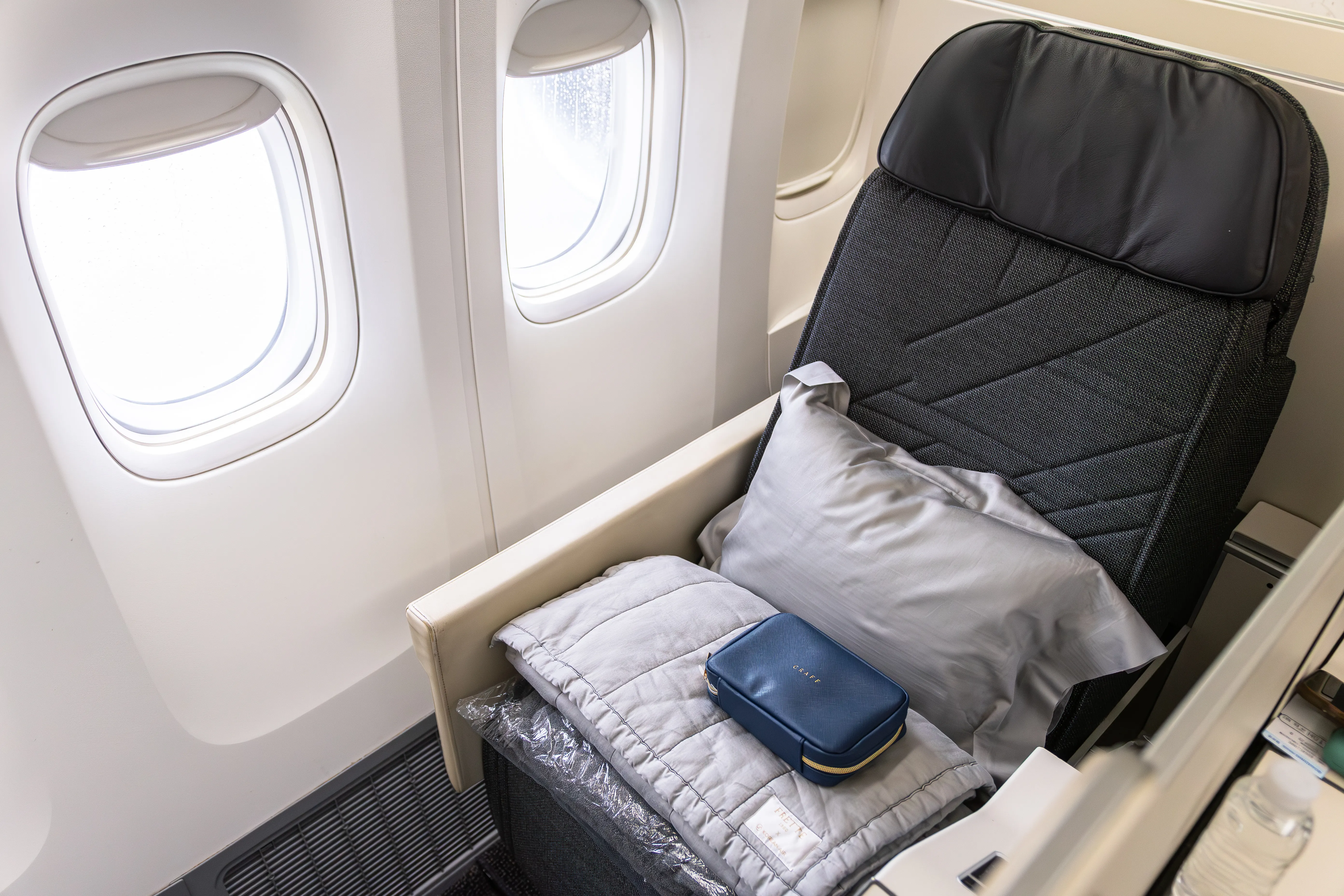
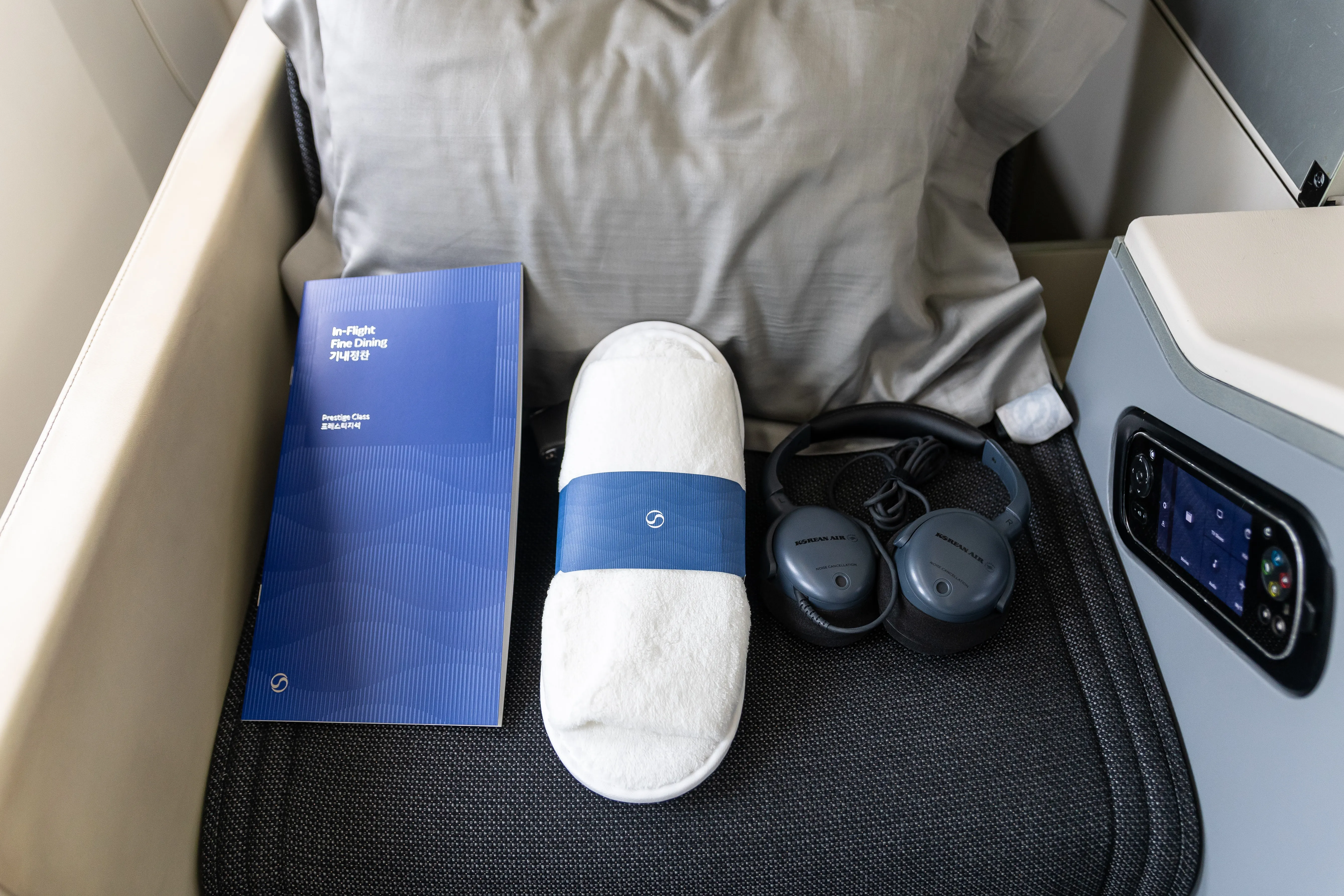
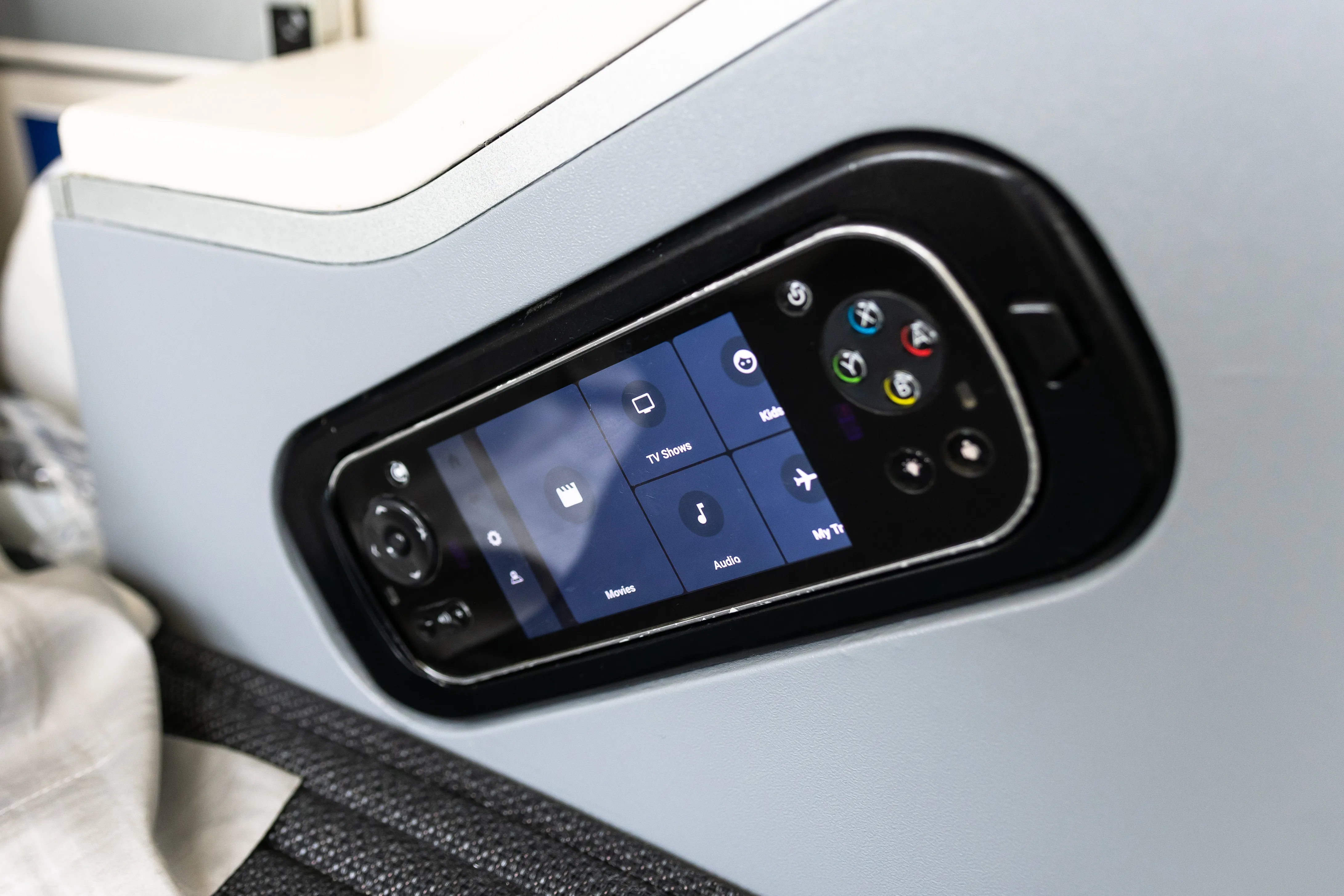
Korean Air’s B747 accommodates 368 seats across three cabins: First Class, Prestige Class, and Economy Class.
First Class accommodates six passengers in its brand-new Kosmo Suites 2.0 in a 1-1 configuration. The private suites include sliding doors, lie-flat beds converting up to 203cm, a personal closet, plenty of storage space, and a wide range of lighting modes. Each seat also offers a large 24-inch IFE screen, a universal AC socket, a USB-A port, and high-quality noise-cancelling headphones.
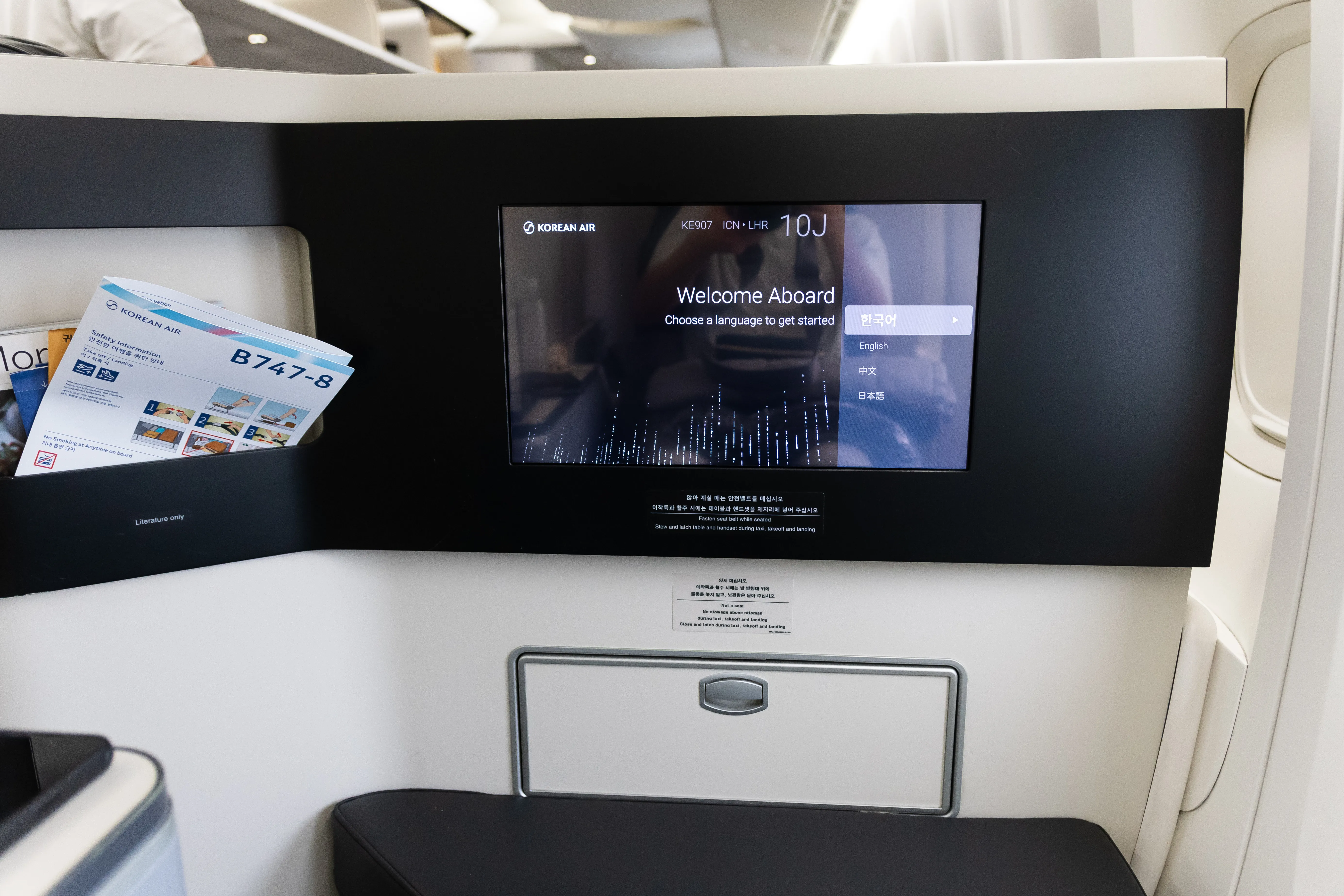
Prestige Class features 48 Prestige Suites in a 2-2-2 layout, with 28 on the lower deck and 20 on the upper. The first-generation suites feature wide, comfortable lie-flat seating with convenient controls, high partitions and privacy, and 18-inch IFE screens with a touchscreen controller. Passengers can find an adjustable tray table, sufficient storage space, a reading lamp, and a power supply beside their seat.
The Economy cabin includes KE’s new product, seating 314 customers in a 3-4-3 configuration. Each seat features vibrant woven patterns that give a fresh feel, a generous pitch of 33-34 inches, a 118-degree recline angle, and an adjustable headrest. Passengers also have an 11-inch IFE screen for entertainment, a power supply, and a USB-A port.
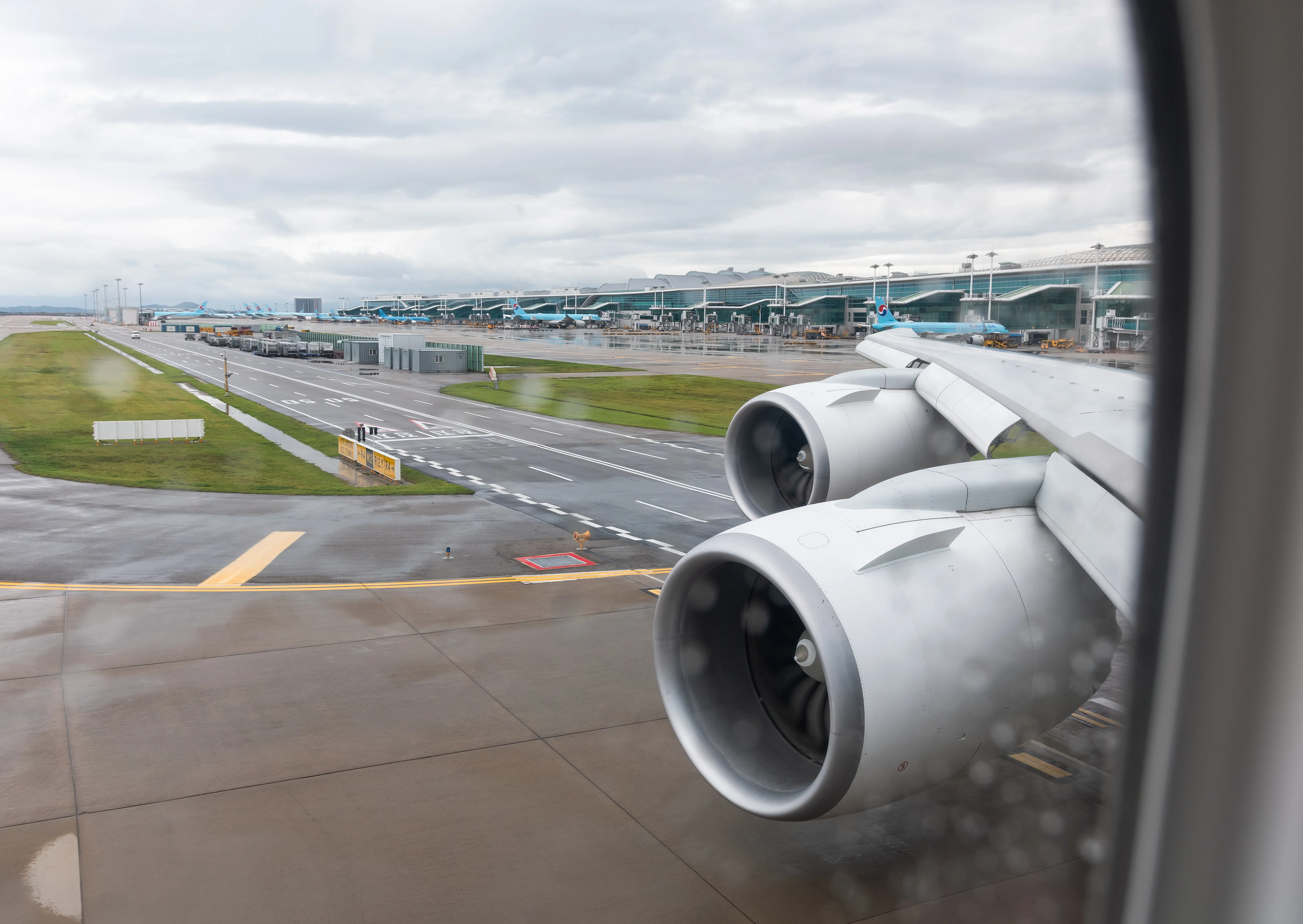
Taxi, Takeoff
Boarding was complete past our departure time, and the purser came through the cabin, apologising to each passenger individually. We were further held at our gate due to recent thunderstorms, which caused a ground stop and congestion at the airport. In the meantime, I made myself comfortable, explored the seat features, and admired the engine view.

Eventually, the weather improved, and we pushed back and started our engines an hour behind schedule. After a short taxi to runway 34R, we were cleared for a rolling takeoff, and the powerful General Electric GEnx engines came to life. Moisture in the air provided a stunning spectacle as condensation flowed through the engines and wings.
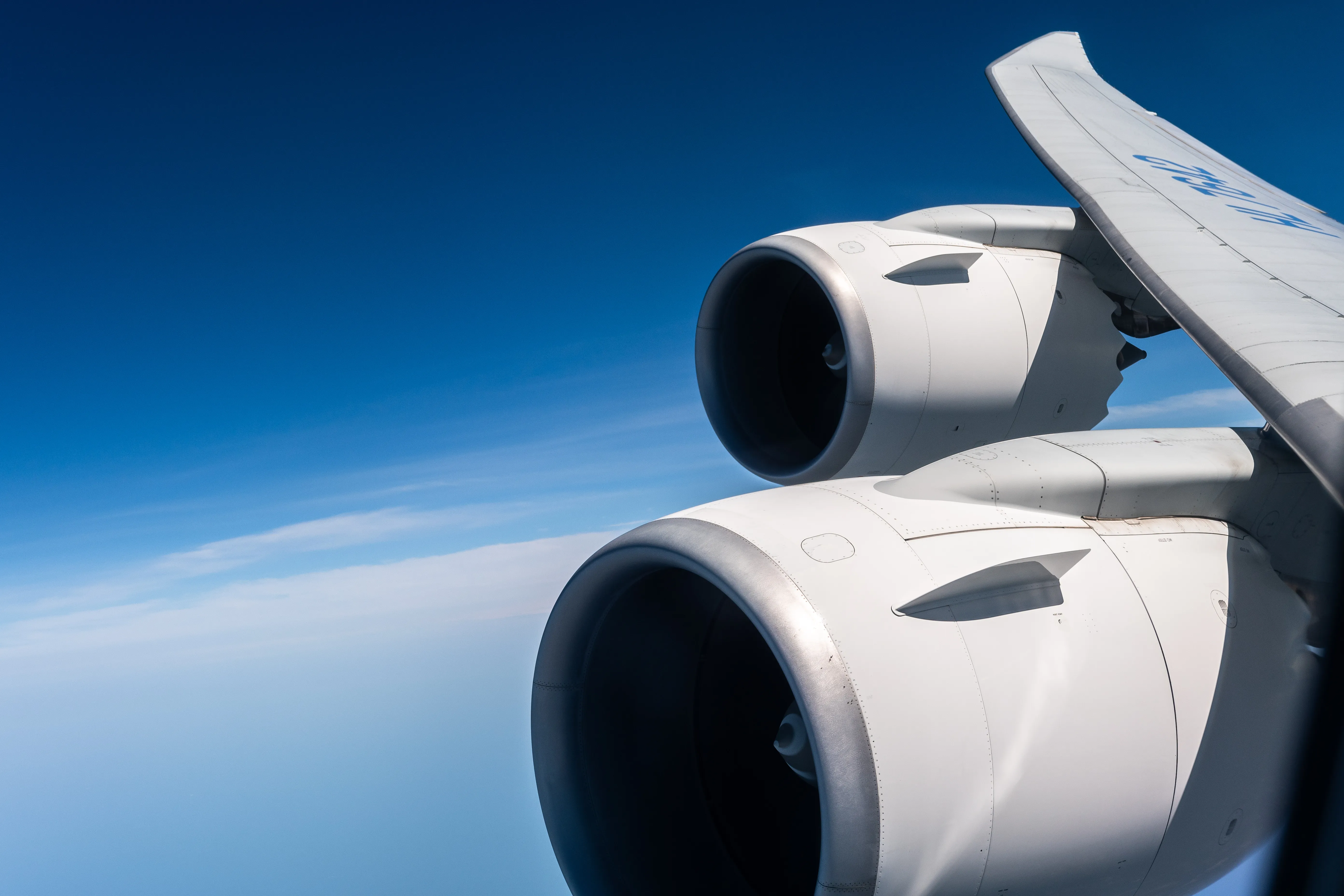
We headed into the low cloud base following an immediate left turn towards the west. The initial layer was thick, and we emerged a good few minutes later. As we reached China’s eastern coast, things cleared up nicely, and I took a few moments to appreciate the world below us.
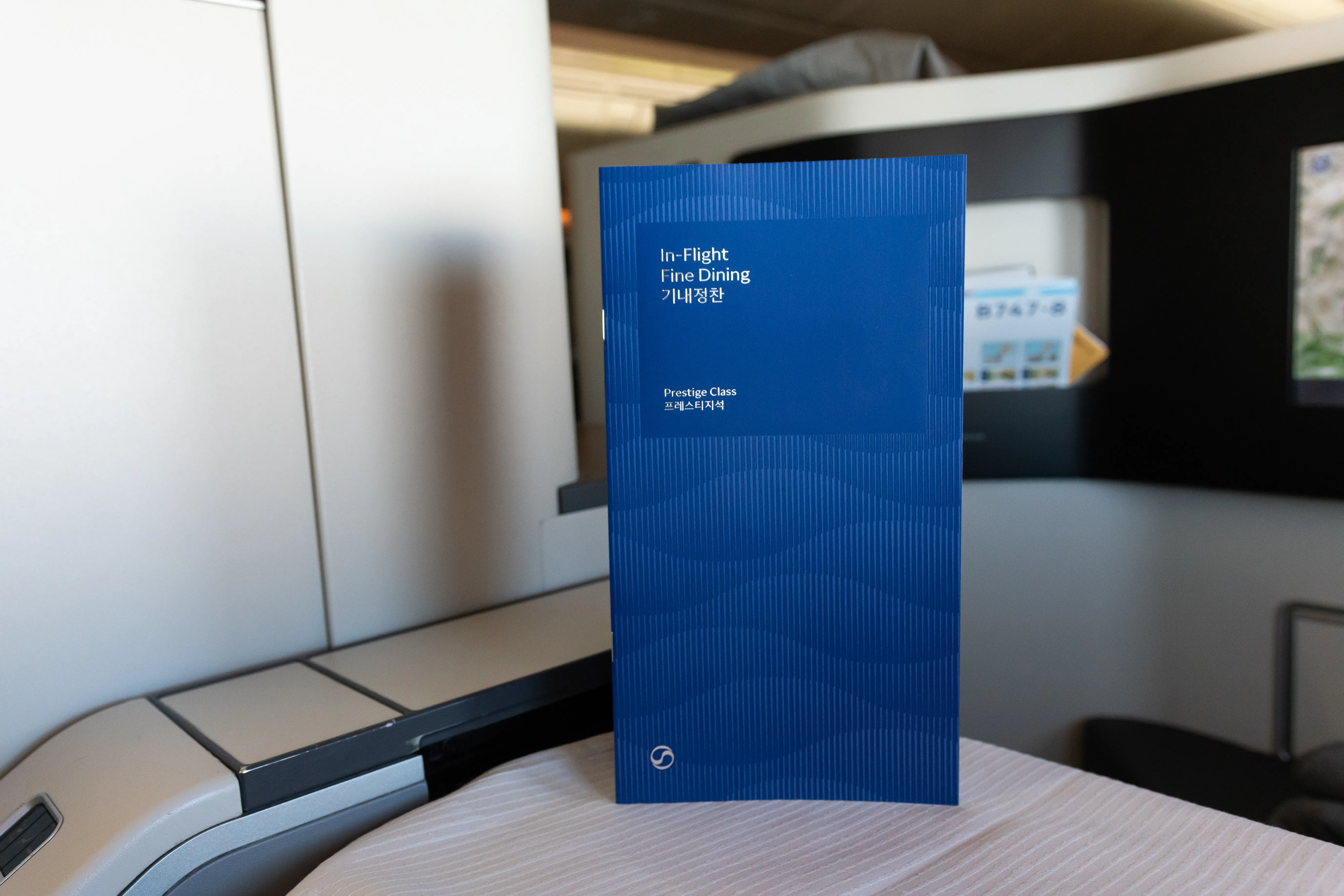
Upgraded Menus
Korean Air has enhanced its menus in collaboration with Chef Saekyeong Kim, designed to align with the airline’s new corporate identity. Through highlighting Korean culinary heritage, the dining experience is elevated with signature dishes such as nutritious octopus rice and beef brisket bibimbap.
To complement the dishes, a premium selection of wines has been chosen through intensive, blind-tasting of over 50 different types. In the list of diverse wines, organic, biodynamic, and vegan wines have been included, sourced from classic and up-and-coming regions.
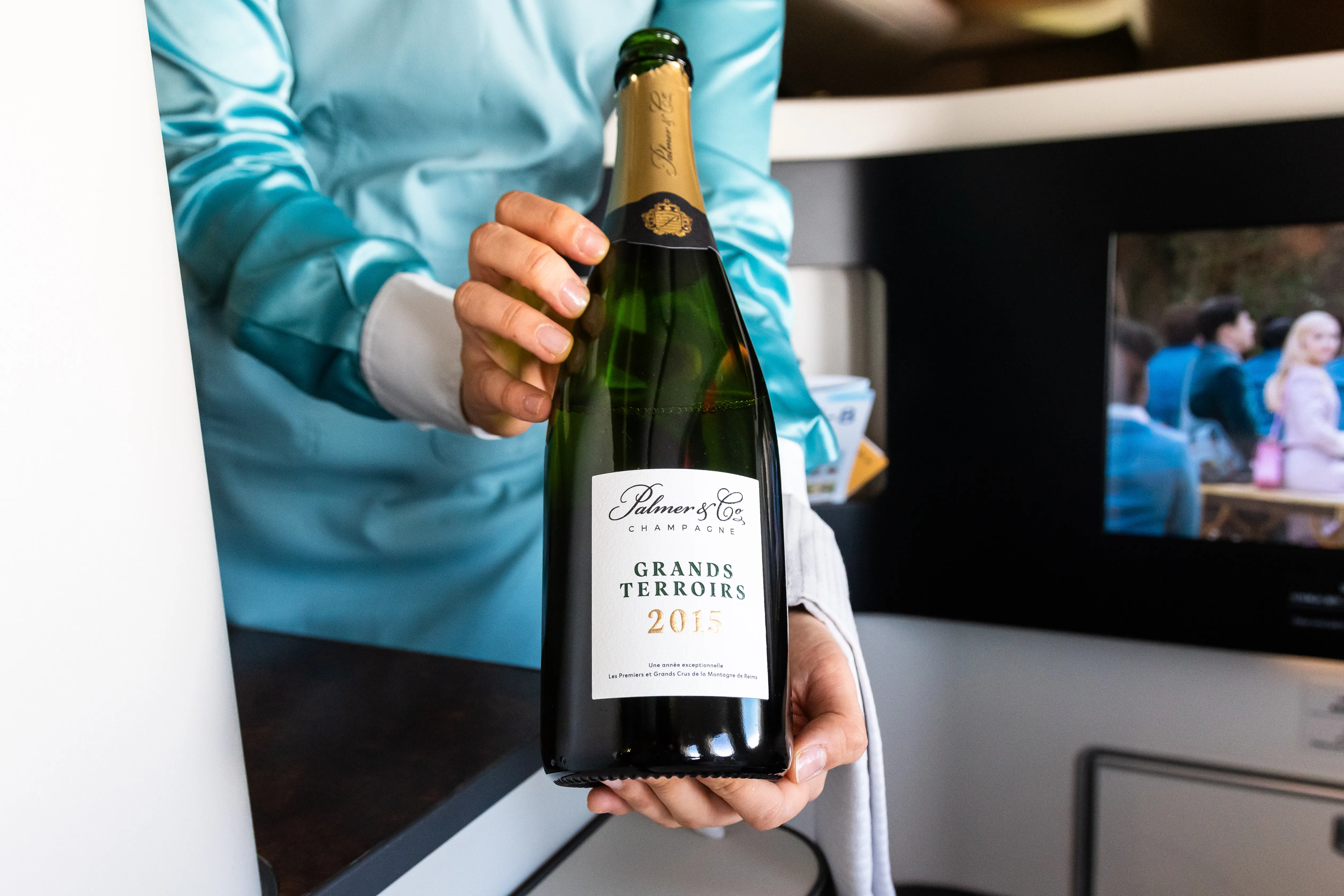
Economy passengers can also expect an upgraded menu, with salmon bibimbap alongside its classic beef bibimbap and stir-fried octopus. Furthermore, tofu pad thai and eggplant stir-fry are among the new menu items, reflecting modern culinary trends.
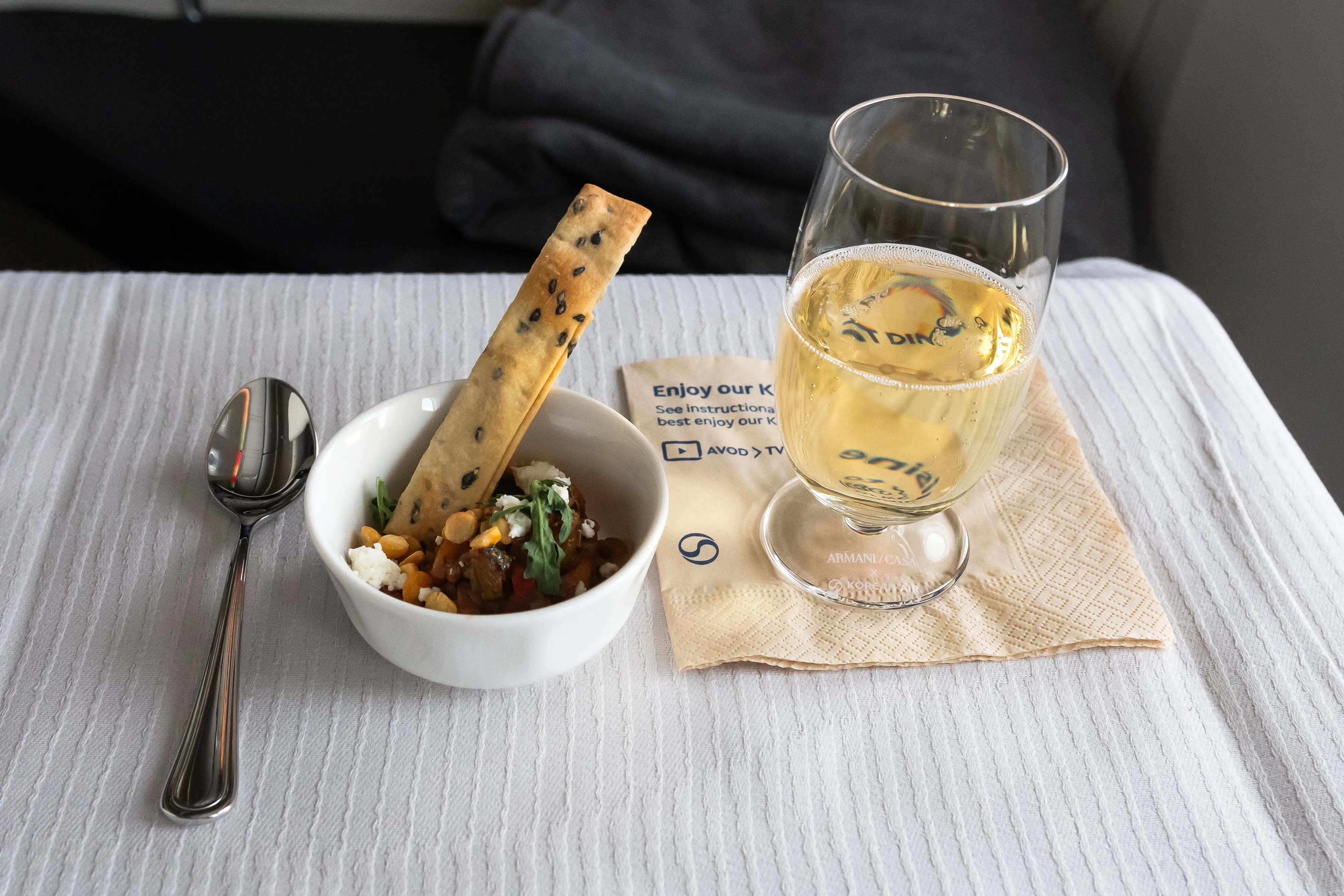
The Prestige Class menu is detailed and extensive, offering up to four main courses for the two meal services. Each dish has its own wine pairing recommendations.
Various alcoholic beverages include cocktails, aperitifs, spirits, brandy, liquor, and beer. Soft drinks, juices, tea, and Starbucks coffee are also available.

In-flight Dining
The dining experience started with a caponata and feta cheese amuse-bouche, and I paired this with Palmer and Co Grand Terroirs champagne.
An appetizer of smoked salmon and potato salad was served shortly after. This came alongside kimchi, spinach, and bamboo shoots, which would be for the following main course.
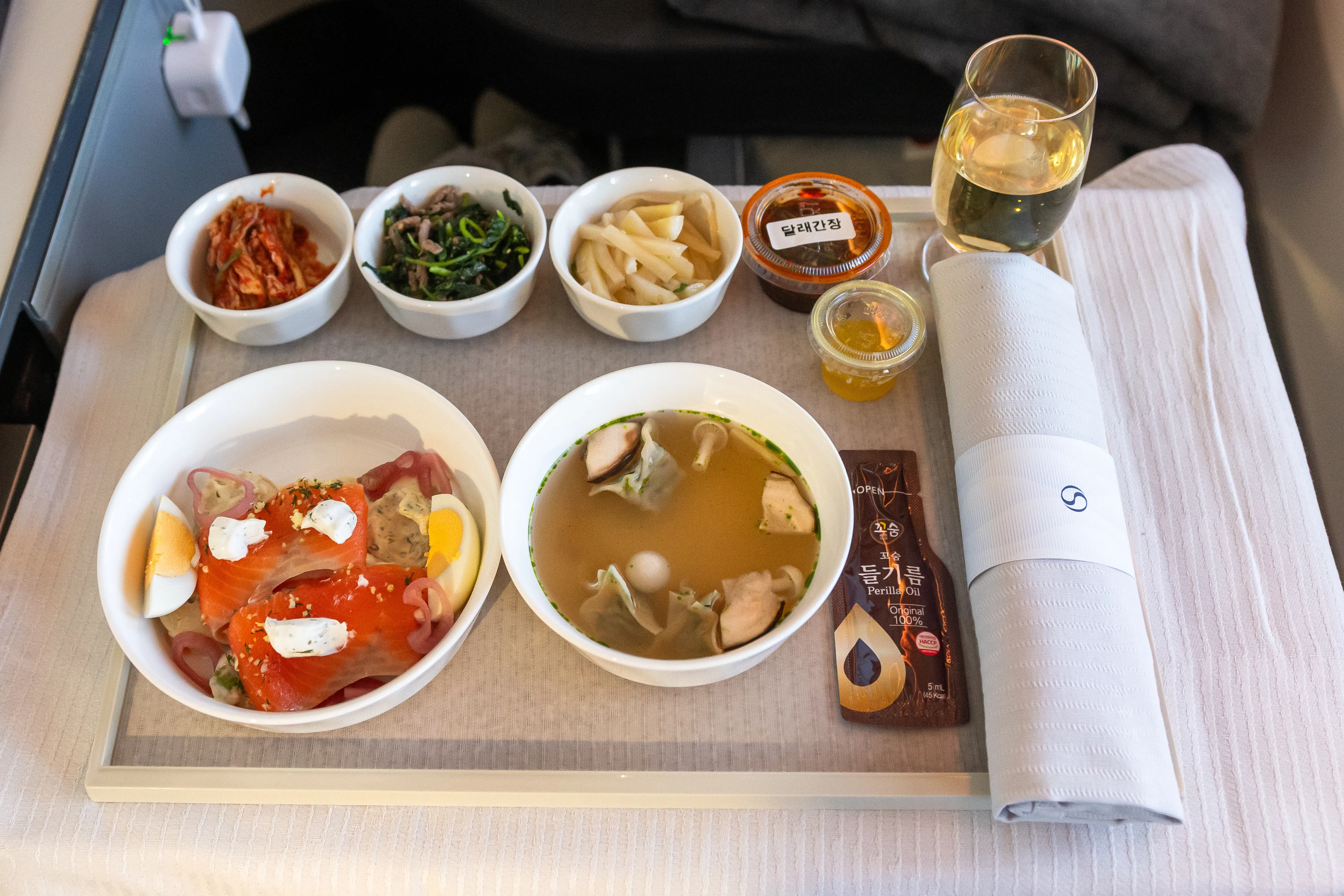
Having previously discussed the onboard options with the crew, they kindly offered me a starter from First Class: a wild mushroom soup with mini beef dumplings.
Both dishes were light, fresh, and flavorful, and my first impressions of the in-flight service were positive.
First and Prestige Class passengers departing from ICN can pre-order meals up to 24 hours before departure online or via the app. Various options were available, including Korean, Western, and Plant-Based dishes.
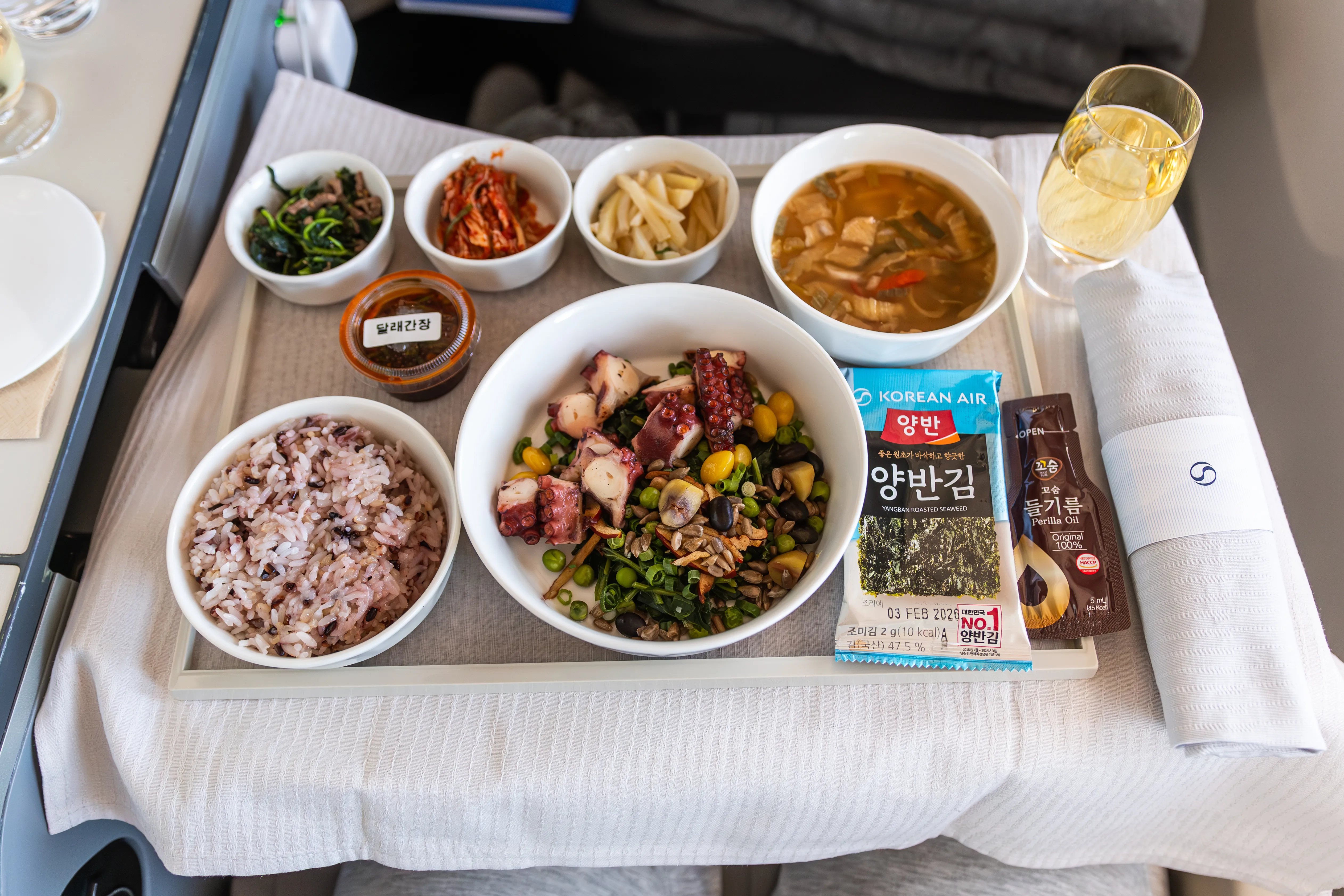
I pre-ordered Yeongyangbap, a nutritious octopus rice dish, which came with a soybean soup, seaweed, and Perilla oil. The meal was hearty and packed with flavour, and the kimchi gave the dish a strong kick. As recommended, I enjoyed a glass of Riesling, which paired perfectly with its fruit and sweet notes.
By this point, I was full up and had no room for dessert (just yet), so I opted for a refreshing peppermint tea.
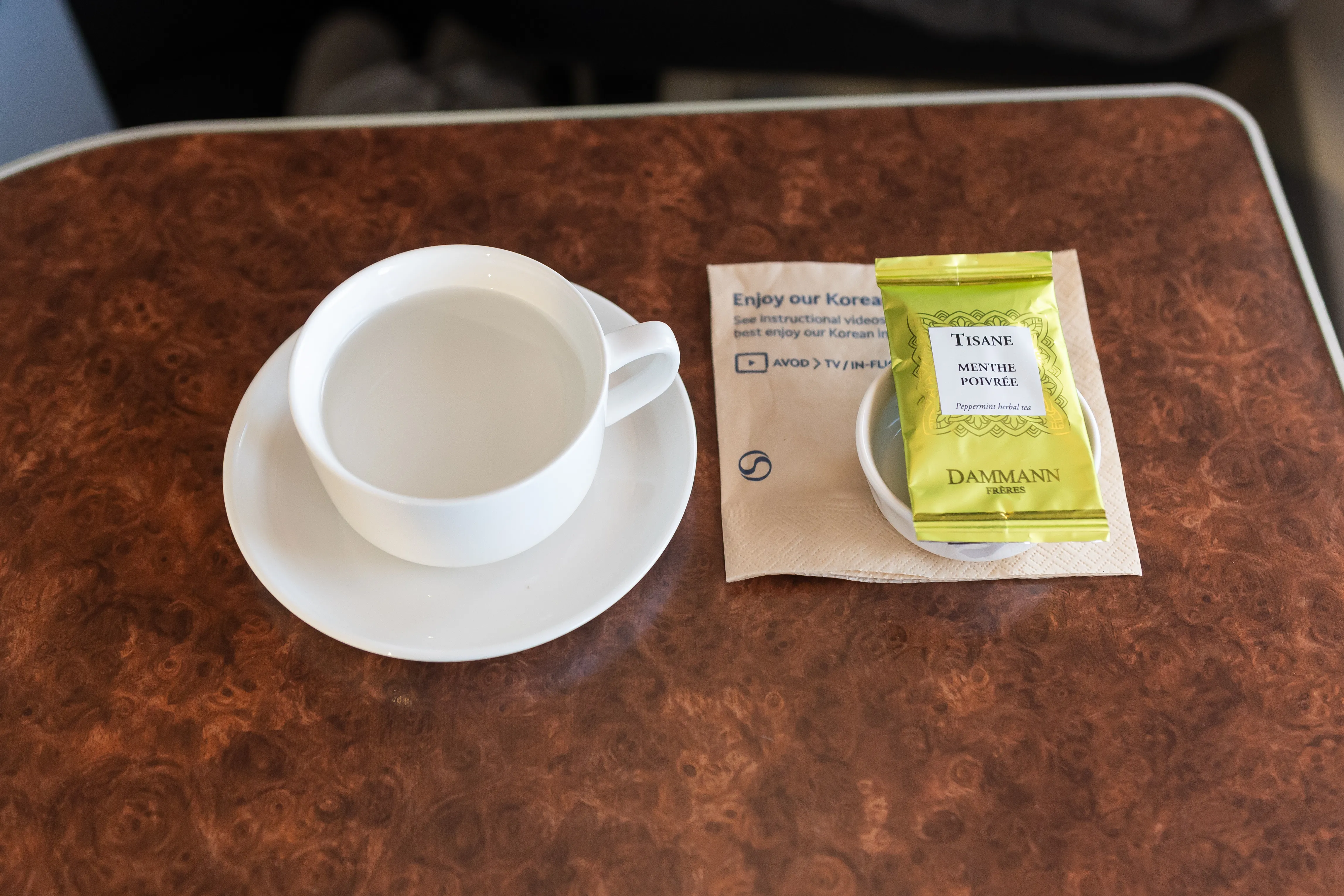
I did eventually have sweet treats later in the flight and was served warm chocolate cookies with chocolate ice cream, which I paired with a Port wine. A classic choice of dessert, but it was a delicious way to end the first meal service and ticked all the boxes.

Amenities, IFE
Korean Air has collaborated with the luxury British brand Graff to provide premium in-flight care essentials. Inside an elegant navy pouch, I found hand cream, lip balm, eye mask, earplugs, eau de toilette, and a dental set.
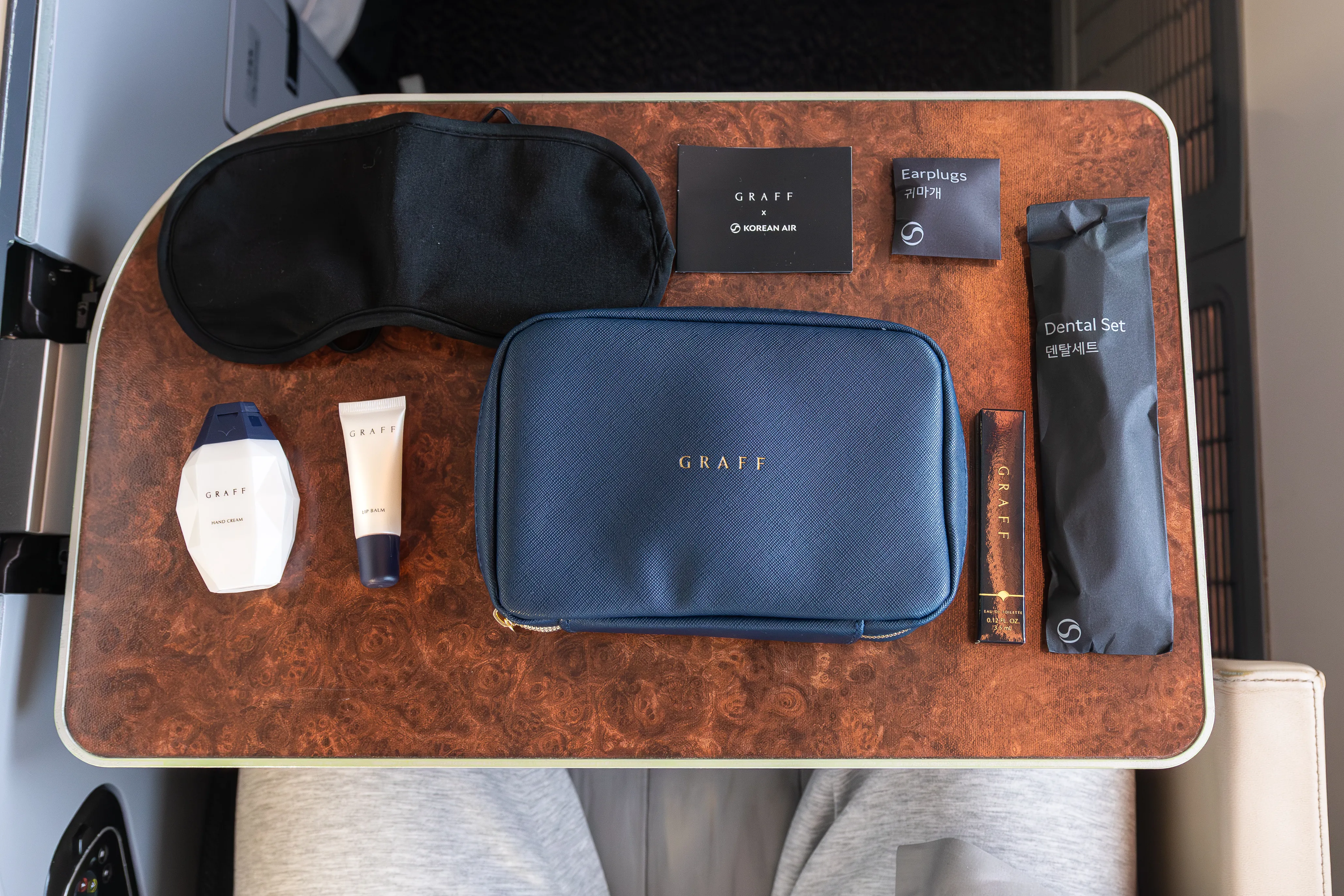
Plenty of amenities were available in the lavatories, including scented Jeju tangerine hand soap, Atelier Cologne body lotion, dental kits, shaving kits, and mouthwash.
KE has a varied selection of entertainment displayed on an 18-inch LCD monitor. A wide range of movies and TV shows was available across multiple genres, with plenty of K-movies and K-dramas.

Various audio albums featuring international artists were on offer, including the global sensation K-pop Demon Hunters, which I had on repeat, of course.
The IFE in general was responsive, and I mainly controlled this via the touchscreen remote controller, with crew call and lighting control buttons. This was convenient as I could easily cast movies to the IFE while having the in-flight map displayed to monitor our flight progress.
An aspect specific to KE is its in-flight dining series: a step-by-step video guide showing you how to prepare some of Korea’s most famous dishes, including staple Bibimbap.
The noise-cancelling headphones worked well, but after extended use, they became quite uncomfortable due to the flat ear pads.

Cruise Phase
Having added the bedding to my seat earlier in the flight, I reclined back and relaxed, putting on a movie. I often admired the view out the window and watched the world go by as it overflew the uninhabited regions of central Asia.
At some point during the flight, I fully reclined the seat for a short nap and was impressed by the comfort of the luxury bedding. The seating was wide, and I found plenty of legroom from the footrest, which I welcomed rather than a restricted footwell.
Throughout the cruise, the crew were always on hand to provide a personal and professional service. They offered drink refills and often came by with juices, including apple, orange, and guava, the latter of which I was a big fan of.
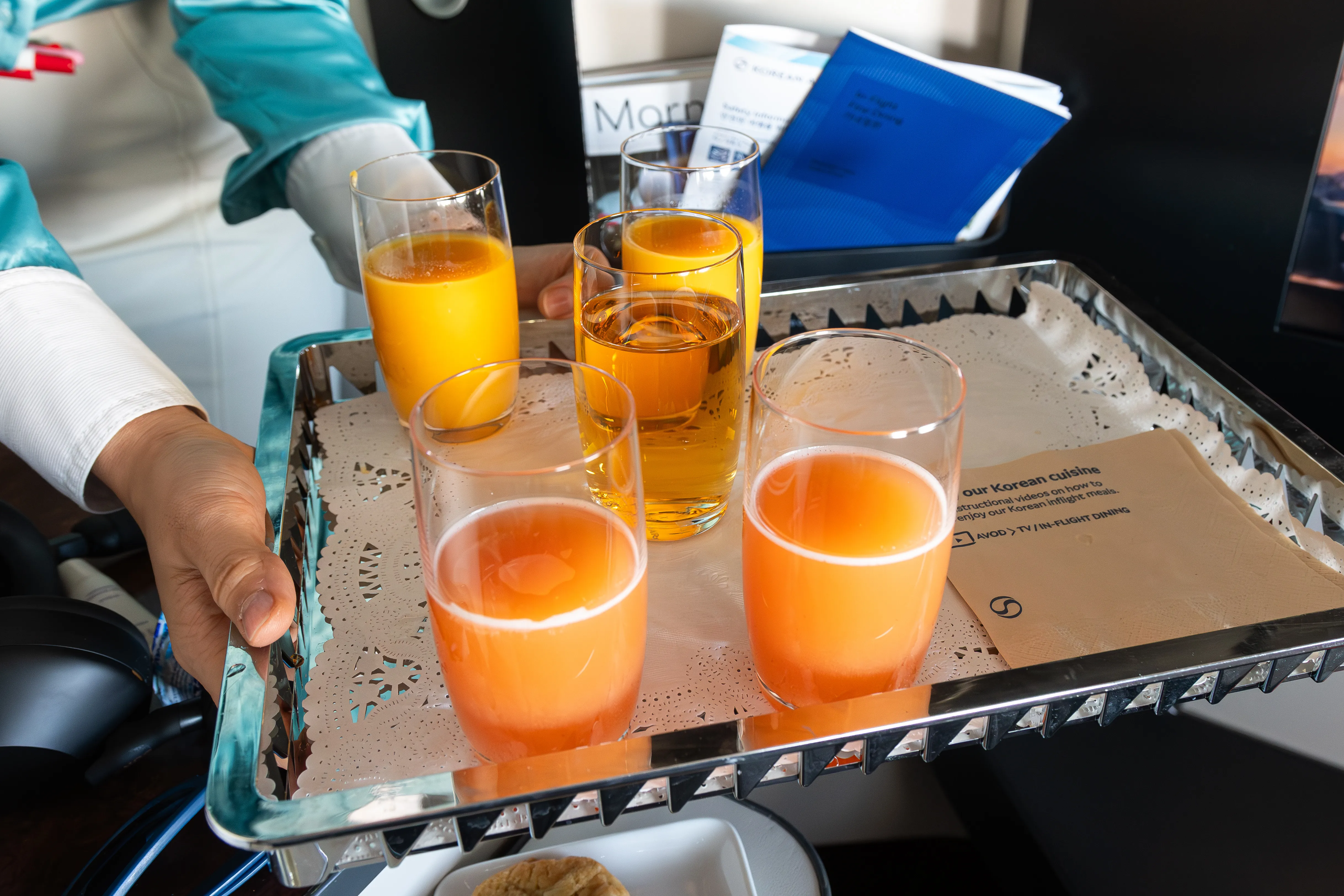
A generous selection of refreshments was available from the snack bar, including Ramen, cookies, nuts, popcorn, and beef jerky. Since this was a 14-hour flight, I aimed to make the most of the experience, and the crew suggested trying a sausage hot dog.
This, I couldn’t decline, and I enjoyed it alongside an expertly crafted Bucks Fizz/Mimosa.
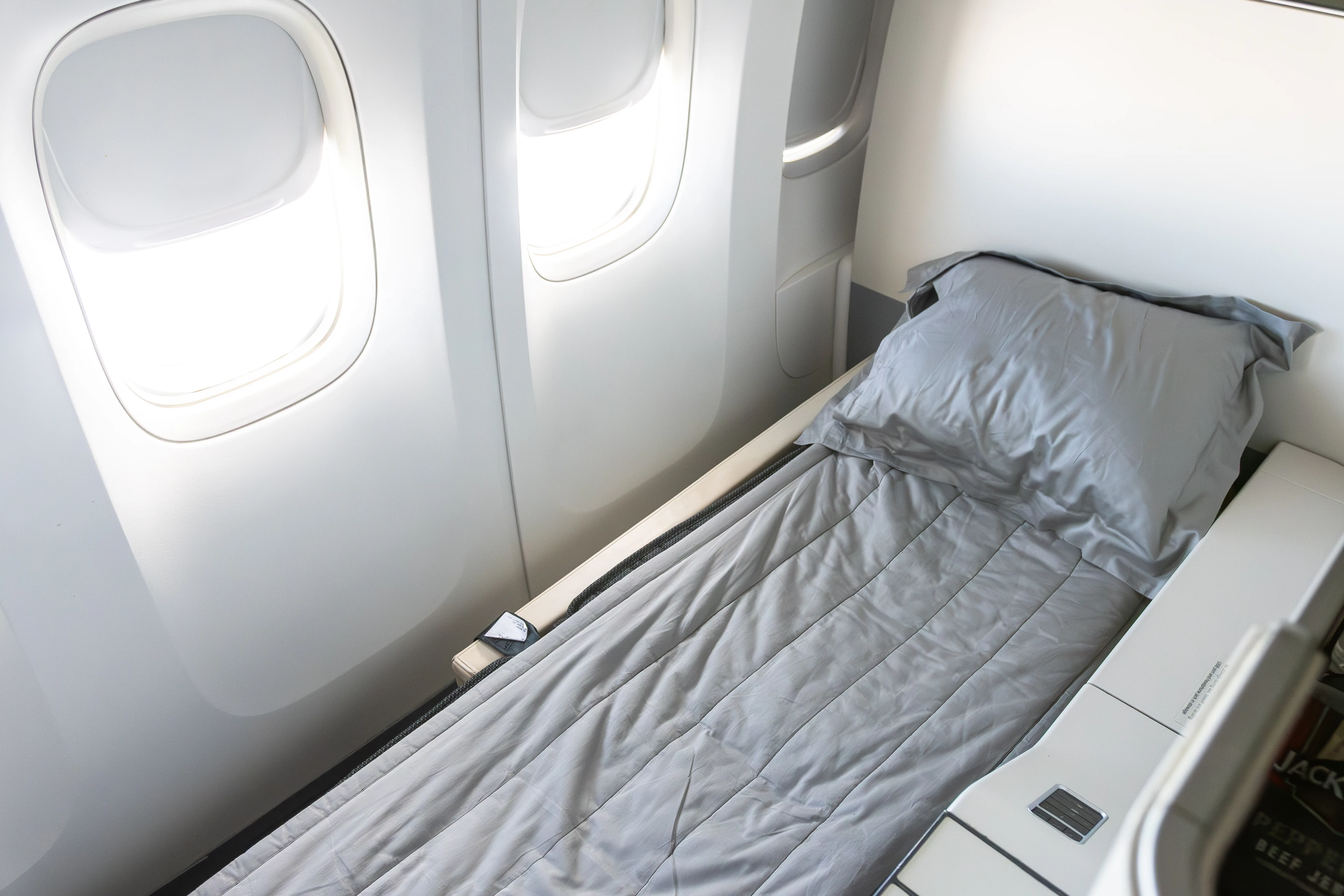
Three Hours to Go
As we cruised at 36000ft over a sunny Eastern Europe, preparations began for the final meal service. The cabin slowly started to wake up, revealing its warm orange and pink mood lighting, and the crew passed by once again to offer drinks.
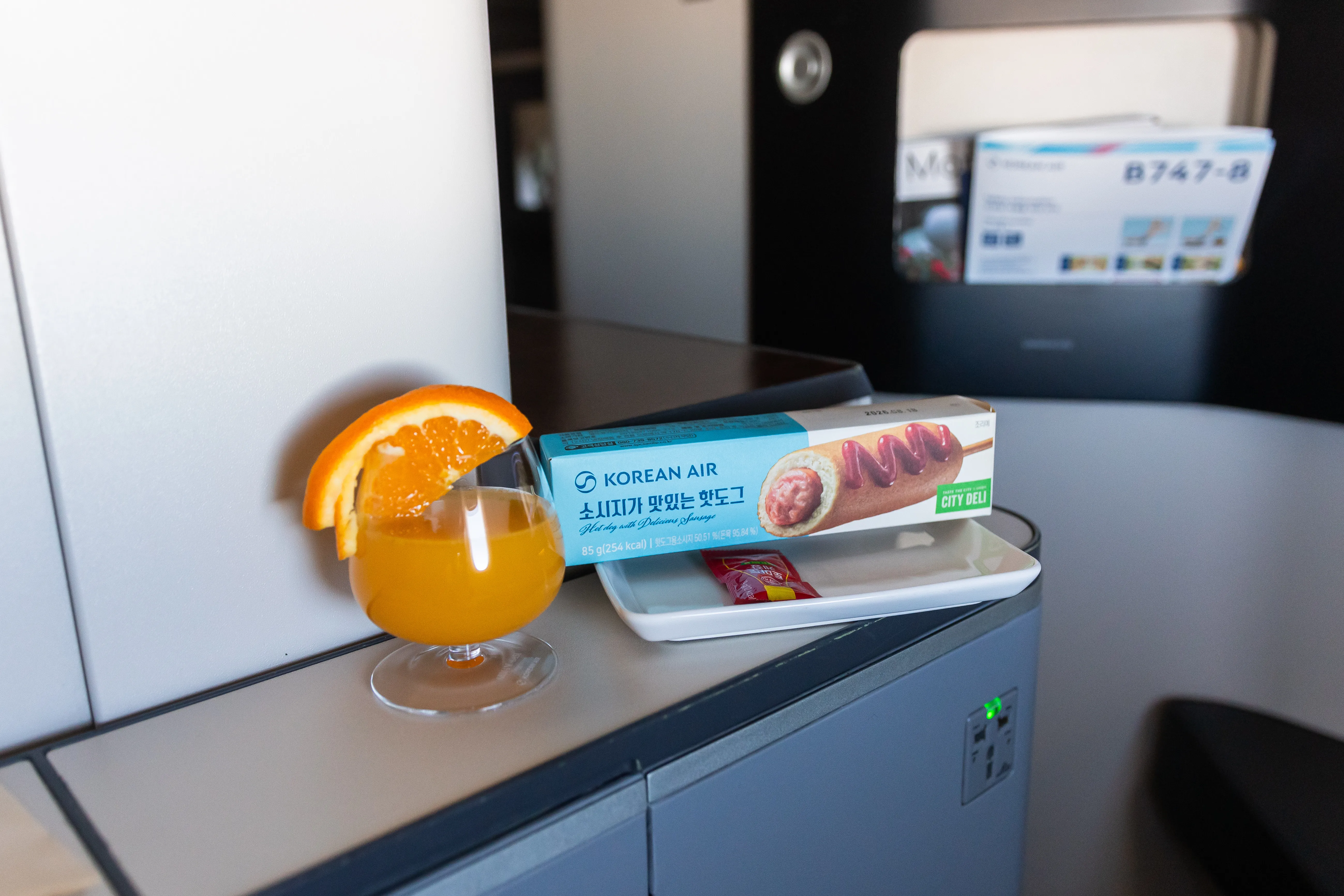
I opted for a refreshing guava juice with my arugula salad starter, and a bread roll and butter. My pre-ordered main, Korean-style bellflower root noodles with mushroom japchae, came alongside kimchi, spinach, and spiced eggplant and cucumber. A bowl of rice and a light seaweed-and-tofu soup were also included.
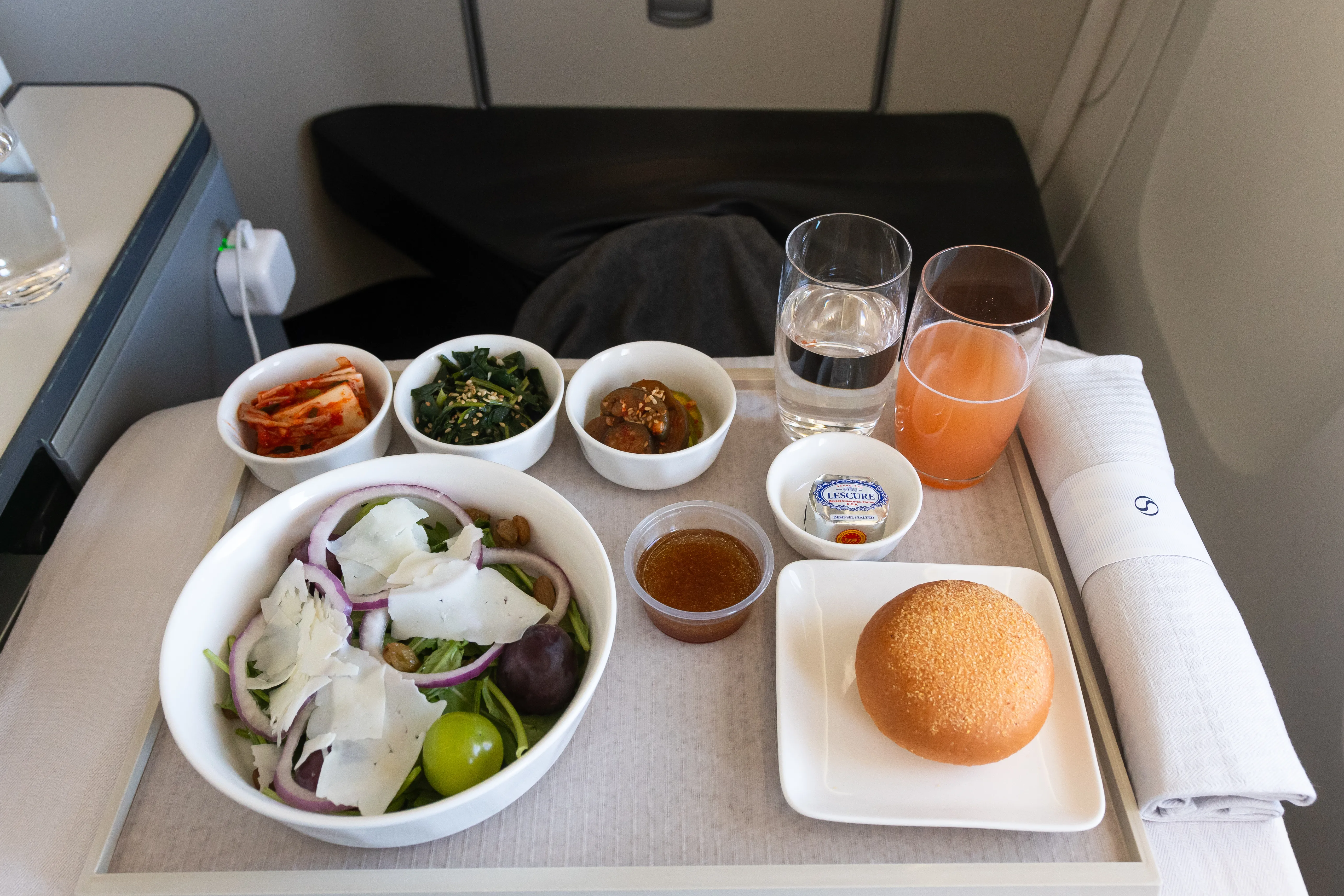
The starter was light and refreshing, and the main course was packed with rich Korean flavours. As before, Riesling was recommended with the dish, and it paired very nicely. Both courses were plentiful, although the double carbs were a little too heavy for me.
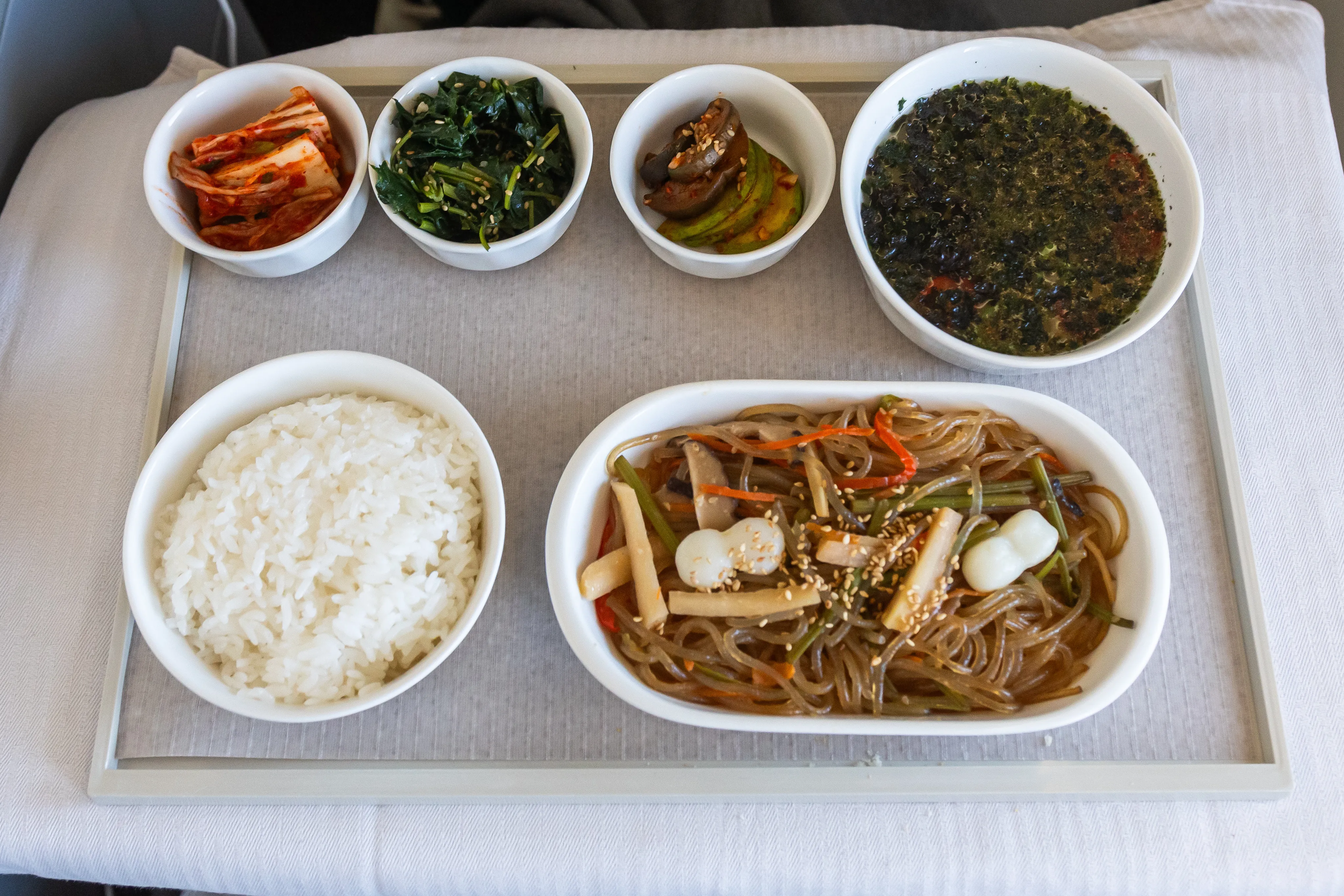
Around an hour later, I found myself with an appetite for a light, fresh fruit and cheese platter, including blue cheese, Camembert, and Münster. Two separate prices for cutlery per dish were greatly appreciated, reflecting the gourmet experience the airline provides.
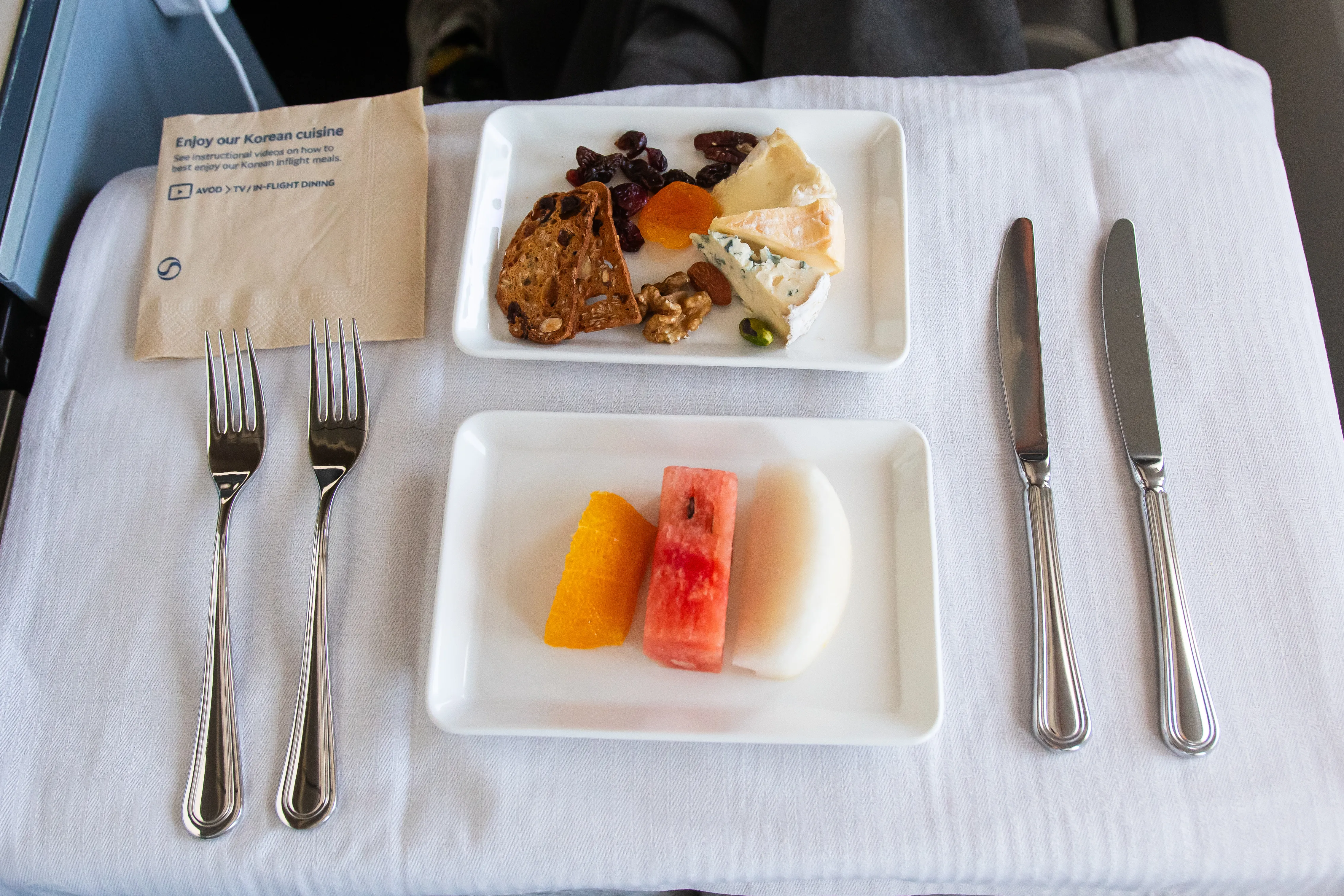
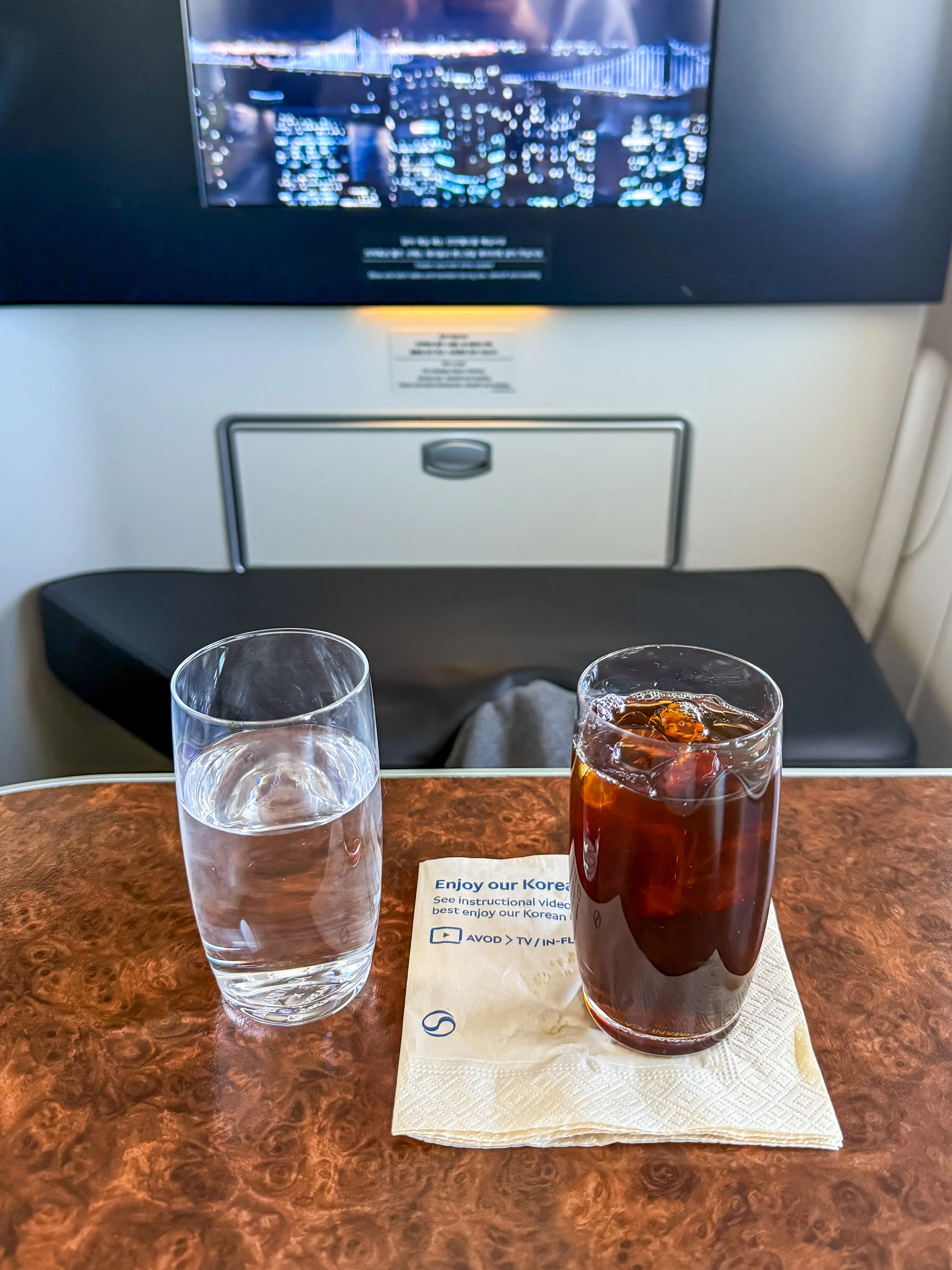
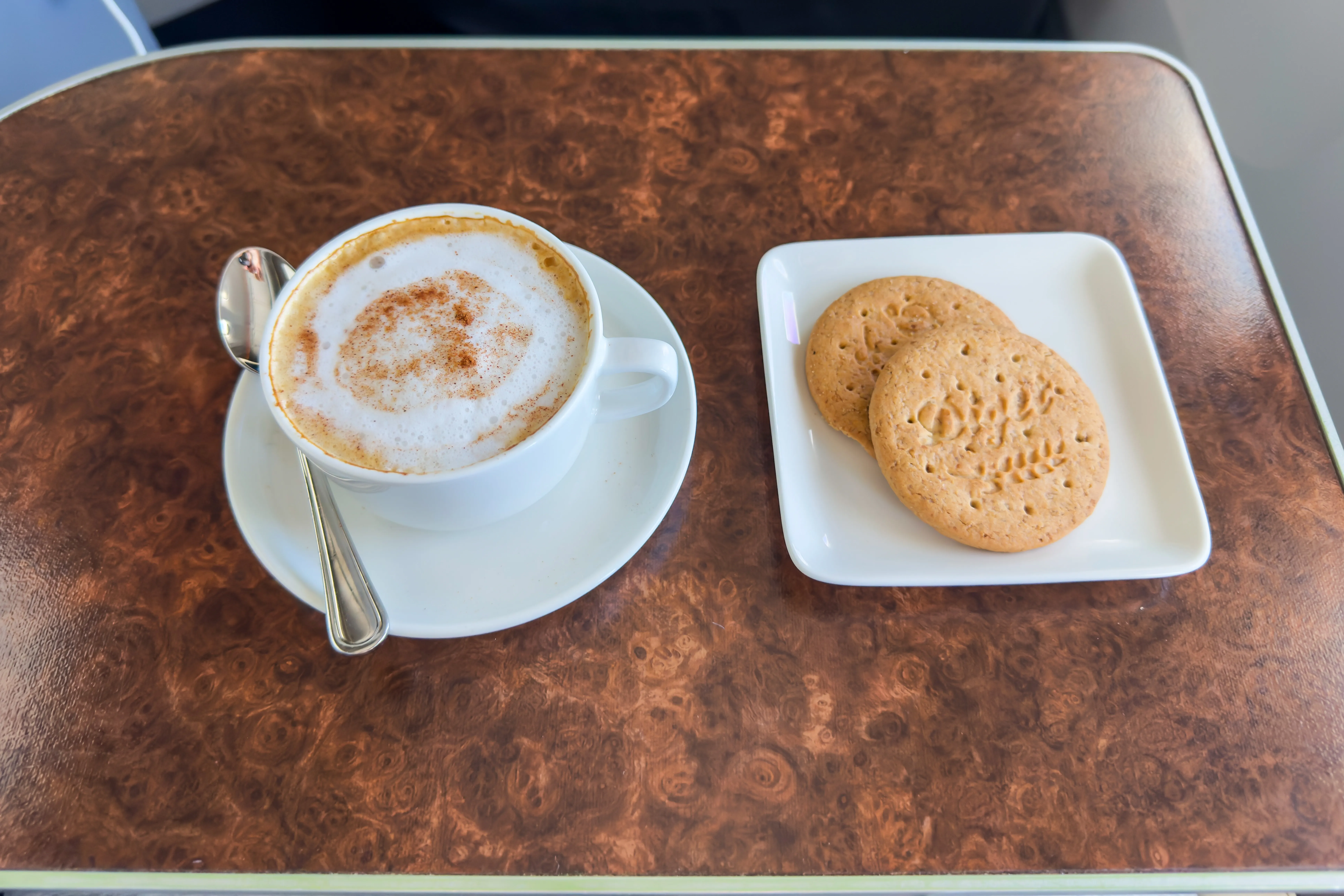
finished off with a refreshing iced coffee, and after talking to the engaging crew, they kindly offered me a cappuccino from the onboard espresso machine, available only in First.
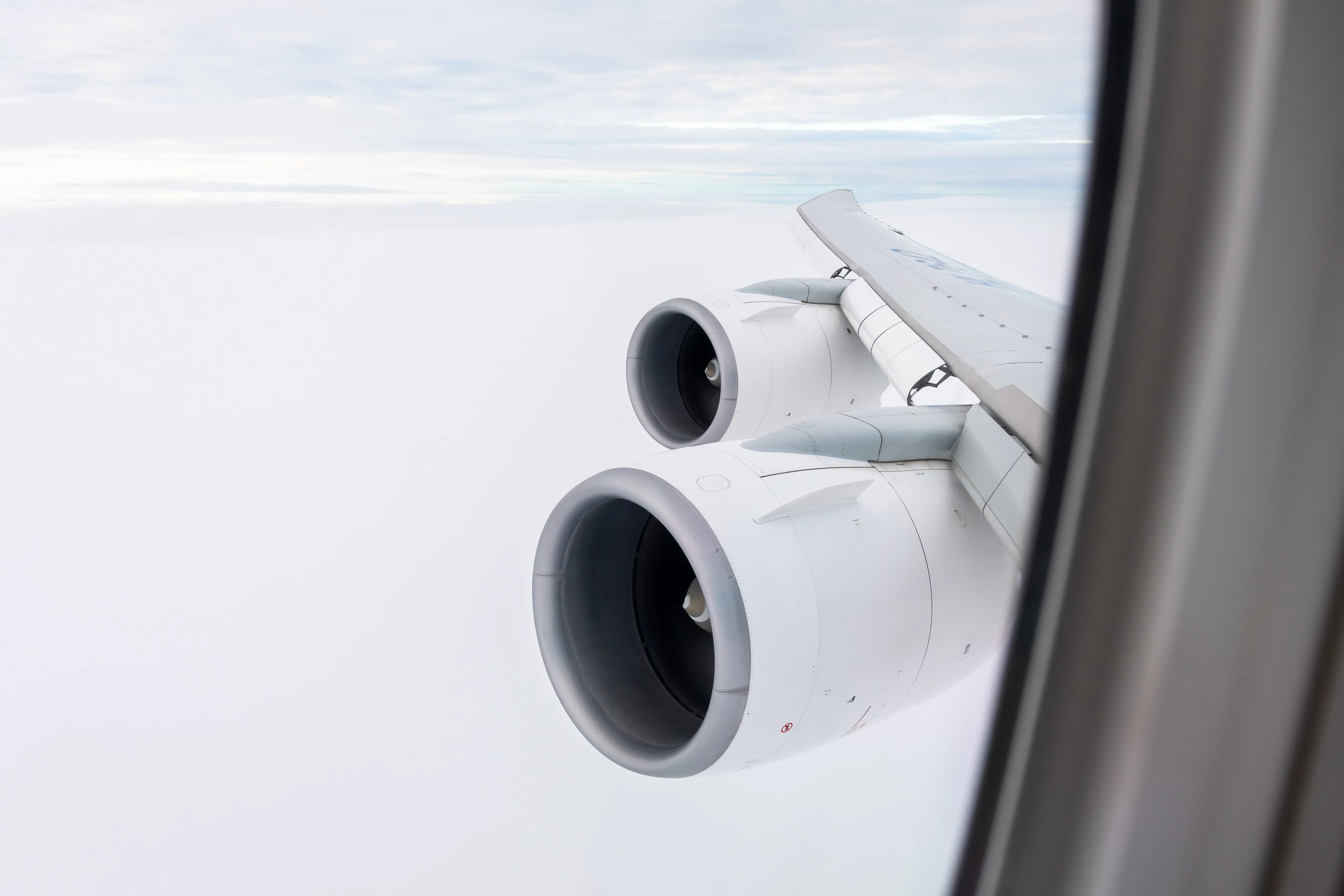
Descent, Arrival
Looking out the window, the cloud clover became prominent below us, and I knew we must have been somewhere over Europe. The late afternoon sun brilliantly lit up the engines, always a treat to see when flying westbound into the sunset.
We entered UK Airspace and joined the queue of inbound Heathrow traffic, with the classic approach over London. A low cloud base, unfortunately, meant no views of the city, and we emerged below the clouds only a few hundred feet above ground.
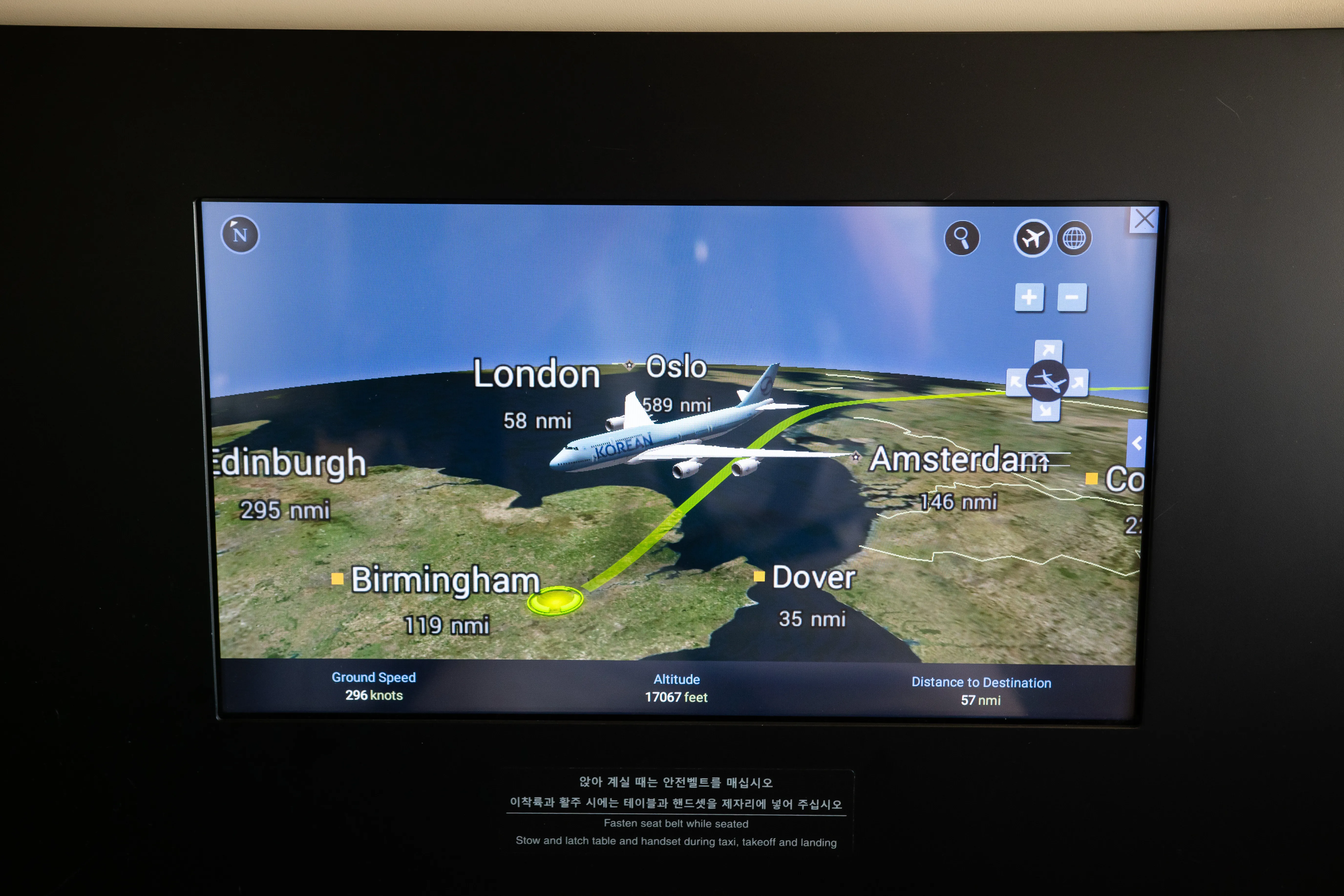
A little over 14 hours of flight time later, we gently touched down on Heathrow’s runway 27R, one hour behind schedule. Rush hour at Heathrow meant we waited a few moments for departures to clear before expediting across 27L, arriving at our gate shortly after.

This concluded the fantastic experience aboard Korean Air’s B747-8. I gave my appreciation to the crew before deboarding, and had a final moment to admire the Queen of the Skies.
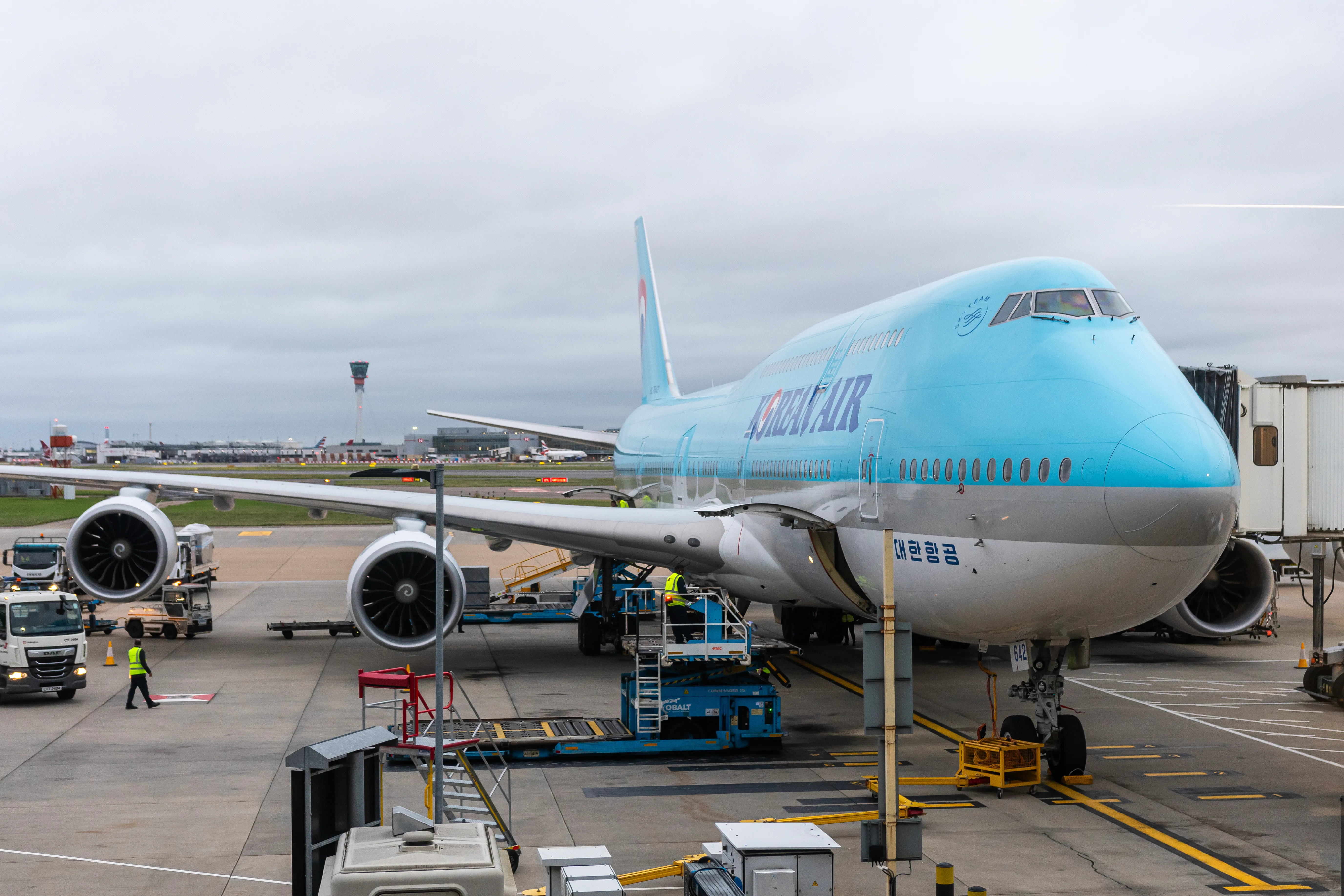
Conclusion
Throughout my stay on board, Korean Air was extremely accommodating, from the warm, welcoming cabin crew to the luxurious seating and dining experience. The Prestige Suites ensured privacy and spaciousness, with wide, lie-flat seating and generous storage space.
I found comfort in the high-quality bedding, the great entertainment from the IFE (and the engine views), and the amenities, which kept me feeling fresh throughout the flight. KE’s in-flight service definitely enhanced the overall experience, and I enjoyed the flavourful Korean dishes alongside various beverages.
However, KE’s B747-8 doesn’t feature its latest Prestige Class product and lacks onboard connectivity, including WiFi and Bluetooth, which would have improved the experience. KE generally serves London with its Boeing 777-300ER, which the airline is currently retrofitting to feature its latest cabin products.
Korean Air’s new corporate identity is perhaps one of the main talking points, marking its first major rebrand since introducing its Tageuk symbol in 1984. It remains a powerful representation for the airline and nation, and the new symbol aims to reflect modernity and minimalism, conveying a premium brand image.
With the full integration of Asiana Airlines in 2027, Korea’s flagship carrier aims to deliver an innovative, unmatched airline experience for all customers. Together with KE’s new visual identity and refreshed products, their vision is to be the world’s most loved airline, connecting the world through the skies.
.webp)

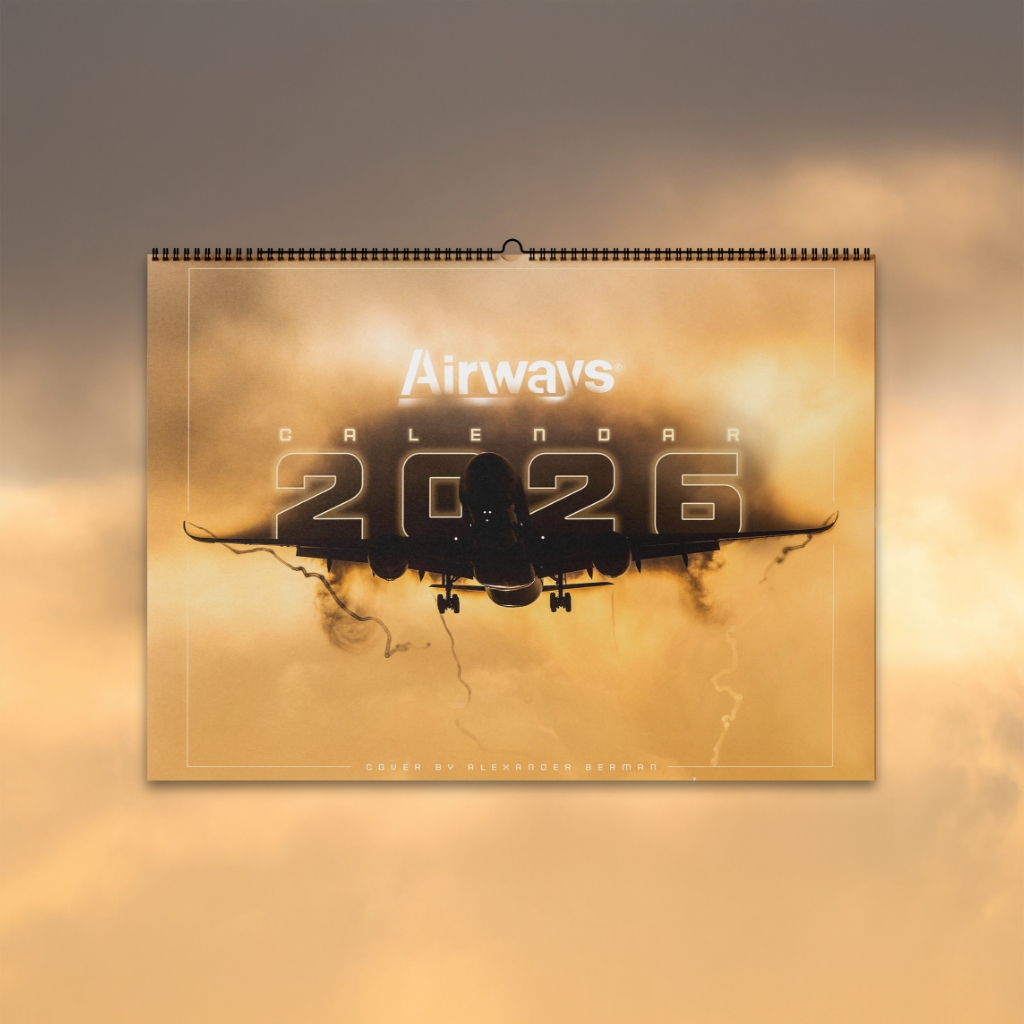
.webp)
